

###subline###

The "STRAYS" Project
A scientific project to determine the most sustainable, effective, and efficient method of managing the number of stray dogs
Stray dog overpopulation is a global concern with implications for public health and safety, environmental protection, wildlife conservation, as well as animal welfare. Irresponsible pet ownership (e.g., abandonment) and lack of birth control programs lead to an increase in stray dogs. In high numbers, stray dogs can contribute to spreading diseases, cause human-animal conflicts (e.g., bites and traffic accidents), threaten the survival of other species of animals, cause economic burdens (e.g., costs associated with management, rabies vaccination), while often experiencing health and welfare problems themselves.
The STRAYS project was developed by the University of Leeds, FOUR PAWS International, and IZSAM (Istituto Zooprofilattico Sperimentale dell’Abruzzo e del Molise 'Giuseppe Caporale'), with the aim to determine the most sustainable, effective, and efficient method of managing the number of stray dogs. Please find our publications and studies about stray dogs here .
Stray dog overpopulation is a global problem that is of public health, animal welfare and environmental concern. FOUR PAWS has been involved in the humane management of stray dog populations for more than 25 years, using Catch-Neuter-Vaccinate-Release (CNVR) to manage stray dog populations. We use this method to humanely reduce the number of dogs while at the same time improving their welfare.
FOUR PAWS vets work with communities across Eastern Europe using stationary and mobile clinics to neuter dogs. FOUR PAWS also supports programs in Germany and Switzerland that help control stray cat colonies through education and awareness campaigns, and by providing support for local veterinary neutering efforts.
STRAYS PhD Research
The STRAYS Project was structured as an academic PhD research study and involved collecting data on dog populations from two study sites (Lviv, Ukraine and Teramo, Italy) and on public attitudes towards stray dogs using online surveys (in Italy, Ukraine, and Bulgaria). Stray dog population size, financial costs, welfare impact on the dog population and impact on public health are some of the factors this study considered when comparing different dog population management methods (catch-neuter-vaccinate-return, long-term sheltering, and mass culling). Collected data was used in statistical modelling to determine long-term effectiveness in humanely reducing population size.
Need to target sources for stray dog population increase
The key result of the STRAYS project is that methods targeting multiple sources of population increase, (i.e., reducing: births in the free-roaming dog population, abandonment of dogs, and allowing owned dogs to roam) are most effective at reducing free-roaming dog population size, while also being cost-effective and improving dog health and welfare. Furthermore, neutering interventions applied continuously (monthly) and covering a high proportion of the population (i.e., >65%) will increase effectiveness and efficiency overall. Mass culling and long-term sheltering do not offer a sustainable solution to stray dog overpopulation, as they do not address the causes for population increase. It is important to also consider public attitudes towards stray dogs and dog ownership practices to adequately tailor responsible pet ownership campaigns.
CNVR & Responsible pet ownership education have the biggest impact
Humanely reducing the number of stray dogs through catch-neuter-vaccinate-return (CNVR) campaigns coupled with responsible pet ownership education represent together the most effective, efficient, and sustainable technique to reduce stray dog population size, while ensuring animal welfare and reduced costs.
Why mass culling and long-term sheltering are not effective and sustainable solutions
Removal of stray dogs from the streets, either by culling or long-term sheltering, does not address the sources of population increase. removal only creates a temporary vacuum in the population that is quickly filled in by other individuals, either through births, immigration from neighboring areas, or through pet abandonment..

Ukraine, Bulgaria, Italy: attitudes towards stray dogs
© 2022 Smith et al. This online questionnaire study aimed at determining the humans’ attitudes towards free-roaming dogs and the dog ownership practices in Bulgaria, Italy, and Ukraine.

Review on dog population management methods effectiveness
© 2019 Smith et al. This review systematically reports about the current research investigating the effectiveness of different dog population management methods.

Using a system dynamics model for free-roaming dog population management assessment
© 2022 Smith et al. This paper presents how to model which dog population methods are the most cost-efficient, effective one and involves a high level of welfare.

Help for Stray Animals
Worldwide projects to help stray dogs and cats .
Interviews & Insights on the Stray Animal Problem in Modern China
I. Introduction
In China, the existence of stray animals has been a social problem for decades. Some — mostly Western — countries that have a rich history in animal welfare have made enormous effort to save the lives of stray animals, but in other regions, specifically in Asia, this problem simply grew more serious in a way that causes greater social problems concerning public health and safety.
In this paper, I aim to discuss the causes and consequences of the stray animal problems along with the challenges faced by the animal rescue community. I discuss these issues in three interviews with experienced rescuers based in China, supplemented with extended research on topics mentioned in the interviews.
II. Interview with Savannah, long term volunteer for four cat rescues in Beijing
Savannah Lee is a full time teacher in an international high school in Beijing. She has been living in China for seven years and participating in stray cat rescuing for nearly four years. She is currently a member of many rescue groups, Cat Community, Beijing Dog Rescue, Kitten Care, and more that offer help in Beijing, Shanghai and a few other cities across China. The interview was conducted on November 12, 2020 via email.
First I asked her to describe the current situation about stray animals in China. In her own words, the situation is “very bad” as many stray cats and dogs are unvaccinated and neither spayed or neutered, potentially creating more strays.
Effective ways to control the stray population include education on animal care, especially on the importance of vaccination and sterilization. Education eliminates the stereotypes that sterilization hurts animals and creates instead an understanding that sterilization brings more benefits to an animal’s long-term health by dramatically reducing the risks of certain types of cancers [1] .
Also, the idea of Trap, Neuter, Release (or, TNR), which is a practice commonly used in the animal rescue communities in the United States and other countries [2] . It is a process where the animal is first trapped, brought to the hospital to be vaccinated and fixed, and released back to the place where you trapped them in. “This is a practice that should be introduced and used more in China.” Savannah said.
Then I invited her to discuss with details on how animal rescue organizations are funded and how they work in China. She mentioned that usually, animal rescue organizations are funded and taken care of by people who are willing to help with their own money, or through charitable donations. Because of the challenges of being self-sponsored, the financial support is limited, and so is the help they are able to offer. When an animal is found, the rescuers will come together to help, first fostering the pet at their house and raising money on their own until they are ready to look for “forever homes”.
She then mentioned the problems of animal rescue work, and introduced three key factors that would help based on her experiences with animal rescue. First, there should be education on how people can join the community and help on animal rescue, and accurate reporting on the situation. People need to understand how to take care of animals, and how much time and money to be invested in animal rescue.
Communication is undoubtedly important as well. Due to the constraints of having WeChat groups as the main tool of communication, people get confused by the many groups with different messages going in and out for just one rescuer, especially during a critical time frame, for example during night time or work hours.
Clarity also contributes to successful communication and the running of the organization. There are groups for animal rescue, for pet related questions, or groups specifically focused on dogs or cats. It is important that people find the right group or community to join, and get passed on the information they need.
As a born and raised American living in China, Savannah experiences major differences between the two countries when handling animal rescue issues, from funding available to the organization to having an actual organization facility or access to what the rescuers need, like a 24 hour veterinary care. Still, education and money are the key. In the United States people are more involved and aware of the animal rescue community compared to Chinese.
One instance of how people might potentially make a change occurred in November 2020, when a company in Shanghai put puppies and kittens into a vending machine where people could pay and play a game, and get the animal as a prize. A video about this went viral where people condemned and protested the exploitation of a live animal in a game. Three days later, the machine got shut down. Together, people can make a difference; they just need a good reason.
III. Interview with Muran, founder and content creator of Loving Home of Muran
Uncle Muran is the founder of a rescue group called Loving Home of Muran in Dongyang, Zhejiang Province, and also a content creator with over 23k followers in Chinese Tik Tok and Little Red Book about his rescue stories. The interview was conducted on November 13, 2020 via direct message on Little Red Book, a social media platform in China.
First I asked about his opinion on the major causes of the vast size of stray population in China, and he answered, “ there is a rising population of irresponsible pet owners that decide to have a pet out of fashion, or, just for a spur of the moment, and when the moment is gone, they simply kick the animals out of the door.” He also mentions that there should be a strictly enforced regulation on pet ownership, which impose punishments on irresponsible owners to reduce such behaviors.
Being a content creator on animal rescue, Uncle Muran uses mainly two social media platforms, Chinese Tik Tok for video-sharing and Little Red Book for both videos and photos with short written posts. I asked if social media is effective as the main tool of communication and information sharing, he said yes because “it helps bring people into this community using my contents, mostly sad videos of strays when they are first taken in, or happy ones when they find homes.”
At the end of the interview, I offered to make a small donation but Uncle Muran immediately refused. He claimed to welcome as many volunteers as possible, but does not encourage donations unless being made in person. In his words, “for donations, we welcome anyone who has visited our base, or has truly known us to donate, and we are very grateful for any donations. However, we do not recommend anyone who we have never met, or spoken before, to make donations because we hope you know that your money is being used in the right place, but with the Internet, you never know, and we do not want to get into trouble.”
Uncle Muran also mentions that he has encountered some content creators who earn a profit by 卖惨, which roughly translates to sadfishing, a new term on social media that refers to the practice of getting attention using people’s sympathy, or making touching videos that do not speak the truth. He expressed a strong disgust to such behaviors.
IV. Interview with the co-founder of Tianjin Stray Animal Rescue Team
The interviewee was unwilling to give out her name nor any other information besides what is shown on her Weibo profile, and she answered my questions with very brief answers, sometimes in only a few words where I could sense that she was cautious when talking. The interview was conducted on November 10, 2020 via direct message on Weibo, a social media platform in China.
First I asked about how the animal rescue group that she is involved in works, and she explained that her team is a small scale rescue group based in Tianjin and that all her teammates are her friends and family. She specifically stressed that “we are not a shelter or any organization, but just a gathering of friends and family who want to help animals.”
Their main source of information is through Weibo. One of the major advantages of having Weibo as the main platform is that all information posted is open to the public whereas in WeChat, people need to be added directly into a message group before accessing any information. Their post content is only seeking adoption for animals they have rescued. The interviewee said, so far, Weibo has been working great for her team.
Similar to Uncle Muran, the team refuses to accept any donations as well. She said “we do not need any. Even if we do, we are more likely to raise money among the people we know, like friends and family instead of asking for donations from strangers.” She knows there are frauds using animal rescue as a hook to make money, and she does not want to give anyone a chance to make profit in this field. “People can always help by volunteering or fostering, which she believes is a better way to contribute in this community.” Clearly for her team, donations are not the best way to help them.
V.Follow-up interview with Savannah Lee in terms of the act of donating
After noticing the different reactions towards donations among three rescuers, I arranged a follow-up interview with Savannah to specifically discuss the act of donating. She has a rather different view and stated that donations are important in keeping an organization alive. In her words, “I do not agree with the statement that rescuers should not ask for money. If they are trusted rescuers then they should. Rescuing animals can get expensive, especially if they get sick. I once spent over 50,000 RMB out of my own pocket on the cats I have rescued and it was a lot of money for me as an ordinary person.”
However, there is only one action that Savannah said some rescuers do and that she was not happy about, which is using the donations for personal interests instead of on the animals that need help. She mentioned that she often heard about rescue groups raising money for a good cause, and then use the funds to go out and eat, or buy things for themselves.
It is interesting to see that different rescue groups handle things differently, especially on the matter of donating behaviors, but the ground rule is that all donations should be used only on the needs of animals.
VI. Conclusion with extended research
a. Lack of legislation on animal protection
China, among many other Asian countries, do not have any legislation and law enforcement for animal protection . Though various attempts have been made by both the people and government officials to raise the concerns of establishing laws for animal protection and against animal abuse, nothing substantial was achieved [3] . Without any active legislation against animal abuse, such acts rarely break any laws, leaving rescue organizations overly dependent on volunteer work and unreliable donation funding.
b. Lack of support for animal rescue organizations
Most rescue groups and animal shelters that are currently operating across China are self organized without any governmental sponsorship. Few organizations have established home bases and full time workers while most are put together by volunteers and operate out of their own homes, usually apartment complexes.. Three major burdens on Chinese rescue groups development are the lack of stable financial support, the lack of volunteers, and a large demand for adoption [4] .
Many rescue groups are founded, supported, and operated by the same group of people with similar interest in animal rescue. It is difficult for them to get outside support due to lack of communication, publicity, and interest from the general public. Another challenge for people working for rescue groups is where to store animals. Without a base, they are forced to bring stray animals back home, or to places that they own, and keep them until they are adopted, causing stress and distraction for their daily lives, especially if their family or partners are not entirely supportive.
c. Lack of education on sterilization
The lack of reproduction control among animals, especially stray animals, escalates the stray population dramatically. Sterilization is an effective method to control stray population, and on the other hand it is also recommended by vets to neuter or spay pets to avoid potential genital diseases or cancers as they grow older. However, it is not a common practice in China compared to Western countries . Many people believe it is a deprivation of the animal’s nature of reproduction, and it is not morally acceptable. Therefore, education on sterilization and its benefits is key to reducing the stray population on a fundamental level.
d. Lack of consistency in existing regulations
Cats and other small animals require no registration and face no ownership constraint. Yet paradoxically, legal dog breed and size are heavily regulated in China. This is similar to the breed specific legislation (BSL) in the United States, which regulates or bans certain breeds that are believed to be aggressive, but the regulation in China is stricter. It both bans many breeds and restricts the size and number of dogs allowed in a household.
In Beijing, one household is limited to one dog, and the maximum height of the dog is 35 centimeters. In the original report it uses the words “ 小型玩赏犬” or small-sized toy dog [5] in English. Dogs need to be registered and inspected annually, so some breeds or larger sized dogs cannot be registered. The cost of registration fee varies in different cities. Some cities like Chengdu offers free registration, but in Beijing, the cost is 1,000 RMB in the first year, and 500 RMB for annual renewal [6] .
By making certain breeds and sizes illegal, the regulations increase the risk of an animals’ subsequent capture and euthanization by the animal control department. The heavy fines imposed by restrictions on unregistered dogs result in more abandonment simply because some dogs legally cannot be registered even in capable households. This obtuse regulation leads to a Chinese tendency to purchase specific, legal permit-friendly dogs directly from breeders or pet stores.
With the lack of animal protection law combined with the heavy restrictions on dog ownership, the concept of responsible pet ownership is only a moral constraint, instead of a mandate that every pet owner should obey. People need to be educated on responsible ownership so that with or without law enforcement, they would not abandon animals.
e. Remarks
Being a dog owner living in Beijing, I sincerely believe China must improve the acceptance and protection of pets and pet owners. Existing pet regulation uses public safety to wrongfully justify heavily regulating the types of dogs that are allowed to live. However, it is the people who need to be regulated. They should be educated on responsible ownership and animal care, reprimanded for animal abandonment, and encouraged to participate in animal rescue.
With national-level legal protections and sufficient knowledge on animal welfare, there will be no animals roaming the streets. Instead, they will be loved in a home where they belong.
- Open access
- Published: 26 July 2023
Public perspectives on strays and companion animal management in Malaysia
- Syafiq Munir Ismail Munir ORCID: orcid.org/0000-0003-4628-1613 1 ,
- Mohd Istajib Mokhtar ORCID: orcid.org/0000-0001-8530-9389 1 &
- Ahmad Firdhaus Arham ORCID: orcid.org/0000-0002-6740-2077 2
BMC Public Health volume 23 , Article number: 1428 ( 2023 ) Cite this article
9127 Accesses
203 Altmetric
Metrics details
Strays and companion animal management is a sensitive issue in Malaysia that incites solid and conflicting views. Through structured questionnaires administered to a random sample of 704 respondents, this study explored public opinion on a) causes of the stray animal population, b) the management of the stray animal population, and c) the national strategy on strays and companion Animal Management. The results show that 70.3% of respondents agreed that a lack of public awareness regarding animal care was the major contributor to the stray animal population. In addition, 58.1% of respondents felt that treating and vaccinating animals exposed to zoonotic diseases is a viable approach that could be instituted as a reasonable measure in stray animal population management. Finally, developing animal protection areas through a multi-stakeholder partnership strategy initiative recorded the highest support (48.4%) for intervention planning for stray animal management at a national level. Notably, a significant percentage of public responses were implicitly influenced by demographic variables. These findings provide valuable insights into public opinion regarding stray and companion animal management in Malaysia. These findings could inform the development of future legislation aimed at reducing the unfavorable effects of stray animal populations on humans and the ecology of Malaysia.
Peer Review reports
Introduction
The current scenario regarding the global stray animal population is overwhelming. The evidence shows that dog populations are estimated to total 900 million [ 1 , 2 ], 83% of which are unrestrained [ 3 ]. The worldwide feral cat population is estimated at least 100 million, including about 60 million in the United States [ 4 ]. In Malaysia, cats and dogs are the two most popular terrestrial animals chosen as a pet [ 5 ]. The ownership of dogs stood at 402,500 and cats at 795,000 in 2018 [ 6 , 7 ]. At the same time, recent development shows that Malaysia was one of the top 10 countries where the pet humanization rate had spiked in 2020 from the past five years [ 8 ].
Chances for owned pets to be assimilated and diffused into the stray animal population are possible if the owner cannot control the excess number of animals, ineffective containment until the animal freely escapes to the external environment, irresponsible breeding, and improper pet care. All these factors have sped up feral and stray animal populations blooming. While the number of stray dogs and cats in Malaysia is still unknown, it is believed the numbers are tremendous, totaling approximately 6 million and 5 million, respectively, compared to the number of owned pet dogs and cats in the country [ 9 ].
Moreover, companion animals such as cats and dogs can have both positive and negative effects on the social community. On one hand, they can provide companionship and emotional support in human-animal interaction contributing to better well-being [ 10 ]. However, when their numbers are out of control or overpopulated, they can also pose a threat to public health and safety. They can transmit zoonoses [ 11 , 12 ], including rabies [ 13 , 14 ], leishmaniasis [ 15 ], toxocariasis [ 16 ], giardiasis, and other zoonotic parasites that negatively affect the health and well-being of both humans and animals. Additionally, stray animals create issues pertaining to waste, sanitation and street nuisance. They often suffer from road accidents and injuries [ 17 , 18 , 19 ]. Therefore, issues related to strays and companion animal management are part and parcel of various multifaced science and social problems that require direct public understanding when creating a management strategy. Regarding intervention implementation, the Malaysian regulations on dog culling do not necessarily align with the World Organization for Animal Health (OIE) standards on animal welfare. Consequently, it reduces the overall score in the Animal Protection Index (API) 2020 which signifies a reduction in Malaysia’s legislation and policy commitment to protect animals. While the OIE accepts that euthanasia of strays may be required, it is the last resort for animals that cannot be re-homed. Adoption and re-homing should be prioritized according to OIE standards [ 20 ].
Limited research in Malaysia regards to stray animal management and measure implementation related to it was identified. Previous research focused on the existence of microbes that potentially causes transmissible zoonotic disease from one animal to another species, including cats, dogs, and humans [ 21 , 22 ]. Another study recently focused on assessing and comparing stray cats’ health conditions between 4 different localities in Johor and identified the existence of six different stray cat breeds in the State [ 23 ].
A previous study by Yong (2015) focuses on addressing the approach and conveying suggestions about managing the problems and issues caused by the overpopulation of stray cats in the Universiti Teknologi Malaysia (UTM) campus [ 24 ]. The study was conducted restrictedly within a specific university campus. Thus, it lacks taking phenomena that could contribute to increasing stray numbers, such as limiting pet numbers on-premises and breeding regulation. Another recent study by Dorothy et al. (2019) focuses on public preferences for trap-neuter-release (TNR) and trap-euthanasia (TE) programs for free-roaming dogs in Penang [ 25 ]. The survey results suggested that the public is concerned about free-roaming dogs and encouraged authorities to seek improved methods of population control that are humane and acceptable to society. However, the small sample population involved a survey of 157 Penangites. The research needs to explore public opinion on how government can enforce strays’ intervention measures starting from its sources, such as limits on cat numbers, breeding regulations, mandatory identification, and desexing.
According to Walker et al. (2017), they identified variations in New Zealand public support for cat population control measures and cat management. They recommended that legislation related to this problem should be reviewed [ 26 ]. Therefore, this current study aims to investigate the perceptions of urban communities in the Klang Valley on stray and companion animal management in Malaysia by focusing on intervention implementation and regulation enforcement. In this context, four stages of questions are applied. 1) Do people in Malaysia do aware that animals are sentient beings? 2) How do different factors contribute to increased stray animal problems in the country? 3) How can individuals and community members manage stray and companion populations within their locality? 4) How can national policy concerning stray and companion animals be designed for the long term? Variations in respondents’ views regarding stray and companion animal management are expected. Therefore, based on the previous studies conducted locally and internationally, the survey will be ethically analyzed on social acceptability, animal welfare, effectiveness, and legal compliance.
The results of this study are invaluable in assisting the authorities to acknowledge that public understanding in stray and companion animal management in the country is of paramount importance. The collated information will invariably contribute justifiable inputs on how the government could draft a sustainable urban development plan by taking into consideration the co-existence of humans and animals residing in the Greater Kuala Lumpur/Klang Valley area.
The scenario of stray and companion animal management in Malaysia and the importance of research in regulation implementation
Matters relating to companion and stray animals in the Klang Valley region are regulated based on different municipalities. The current Ministry of Local Government Guidelines emphasizes stray dog animal control, resulting in most captured animals being euthanized [ 27 , 28 , 29 , 30 ]. There are few federal-based national regulations for protecting companion animals, including dogs and cats, in the region. The Animal Welfare Act 2015 is the only legally binding document that prevents cruel actions toward animals while promoting their welfare [ 27 ]. The Act has only been enforced since 2017 despite being passed by the Malaysia Parliament in 2015. Therefore, is a need for in-depth, progressive studies on aspects of its implementation. Implementing national legislation on animal matters is the sole prerogative of the Department of Veterinary Malaysia and municipal authorities. However, commitments toward providing minimum standards for treating and protecting companion animals remain under the purview of the public community.
In 2009, the OIE adopted animal welfare standards applicable to stray dog population control in different countries worldwide to reconcile with the existence of the Terrestrial Animal Health Code. The OIE standards are not immediately binding but represent a fundamental tool to combat zoonotic diseases and other nuisances that stray and free-roaming animals generate. According to these recommendations, once stray dogs are released into the territory, they should be returned to a place that is as near as possible to the place of capture, their welfare should be regularly monitored, and they should be easily identifiable on sight (e.g., visible collar) to avoid unnecessary recapture. It also recommends that if this method is adopted, awareness of the program within the local community should be increased to ensure widespread understanding and support. Article 7.7.7 (4) emphasizes that continuous evaluation should be carried out in particular milestones to check whether the program has the desired and stated impact. Depending on the required objective, the Article suggests several approaches should be adopted (Table 1 ).
Studies conducted internationally suggest that public opinion regarding companion animal management differs according to several demographic variables, namely, knowledge and experience, employment status, gender, and religious beliefs [ 31 , 32 , 33 , 34 ]. Gates et al. (2019) highlighted opportunities to improve owner compliance through desexing, micro-chipping, and registration of dogs and cats in New Zealand [ 35 ]. Opinions towards managing stray cats and dogs vary between pet owners and non-owners. A survey by Rand et al. (2019) reveals various views among the public regarding the lethal and non-lethal practices employed in stray cat management in Australia [ 36 ]. Ultimately, they conclude that current local legislation does not reflect public views and should be reviewed.
Methodology
Location, duration, and design of the study.
The Klang Valley region in Malaysia was chosen as the target location to investigate the perceptions of urban communities on stray and companion animal management in Malaysia. Klang Valley was selected because the region has the highest population in the country, totaling approximately 7,780,000 inhabitants [ 37 ]. The sample was randomly selected from among the public (aged 18 years and older) living throughout 10 localities in the Klang Valley (see Fig. 1 ) map from Fandi et al. (2020) [ 38 ], and data collection was undertaken from 1 st March 2018 to 31 st March 2019. The percentage of approach to all potential respondents are equally distributed to all localities in the Klang Valley, with a higher percentage allocated for Kuala Lumpur due to its larger area size and higher number of population (see Table 2 ). A simple random sampling technique was used to prevent bias and implement an appropriate methodology that ensured every member of the population had an equal chance of being selected [ 39 ].

The studies areas within Klang Valley region. Map credit to (Fandi et al., 2020) [ 39 ]
The questionnaire was adopted and modified from previously published work [ 25 , 26 , 35 , 40 ]. The questionnaire was designed to apply to all participants, regardless of whether they kept animals. To avoid confusion among respondents about the etymology of companion and stray animals, the animals were defined as follows:
A companion animal is a common domestic animal, such as a cat or dog, that lives with humans and depends on humans for its welfare.
A stray animal is a companion animal (e.g., cats and dogs) that are lost or abandoned and lives as an individual or in a group. Stray animals live around the centers of human habitation.
The questionnaire was divided into the following five sections:
Human and animal continuum of knowledge and awareness
Causes of the stray animal population.
Management of the stray animal population
National Strategy on Stray and Companion Animal Management
Information on respondents’ backgrounds.
In the first section, respondents were asked about their knowledge regarding the continuum of human and animal relationships, including awareness of rights and animal welfare protection. Respondents were asked whether they agree with the following statements: a) Malaysia currently provides viable acts and regulations as guidelines for the protection of animal welfare; b) people adhere to animal based-rules and regulations; c) Animals have a creative mind with the potential to reason; d) Animals possess the capacity to have feelings, such as love and pleasure; e) Animals possess the capacity to have feelings, such as pain and suffering; f) An animal should be given moral consideration equivalent to a human being whilst still alive; g) Animals should be treated equally to a human being, such as being given inheritance rights; h) Animals should be treated equally to a human being, such as being given citizenship rights; i) Dead animal carcasses should be given the same respect as when they were still alive, and j) Religious knowledge is imperative for animal welfare protection. Respondents could select multiple answers in each section.
In the second section, respondents were asked for their opinions regarding the claim stray animal issues in Malaysia cannot be resolved effectively. Choices of possible answers encompassed the following reasons: a lack of general public awareness of animal care, limited promotion through media platforms, the burden of animals’ behavior, financial issues, the ineffectiveness of the existing national strategy to manage stray animal populations, the scarcity of animal registration platforms, lack of enforcement, a limited number of competent enforcement officers, lack of CCTV at hotspot areas, the inadequate number of compounds, pet shops discarding animals, ineffective provision of desexing treatment, religious/cultural sensitivity issues, the ineffective approach of animal rescuers, and the limitations of protection sanctuary area(s) for stray animals. Respondents could select multiple answers in each section.
In the third section, respondents were asked for their opinions on how to manage the stray animal population effectively. The range of techniques includes lethal methods such as shooting and euthanasia or mercy killing. Respondents may choose suspending pregnancy (using non-surgical method of contraception) as a reversible method for blocking fertility or termination of pregnancy as an abortion measure. In relation to the surgical approach, Trap-Neuter-Return (TNR) allows strays to be humanely trapped, neutered or spayed, and then released back into their original habitat. Desexing/sterilization using the neutering method (non-TNR) is commonly applied to control the pet population and reduce unwanted behaviors such as aggression and roaming. Other available options are treatment and vaccination of animals exposed to disease, socializing with public communities, re-homing/ relocation, readopting, and leaving the animals alone. Respondents could select multiple answers in each section.
In the fourth section, respondents were asked for their opinions on the national Strategy of Stray and Companion Animal Management. Respondents chose answers based on the suggestions, which were was: limit the number of household pets, embargo for certain types of high population animal species such as cats and dogs, compulsory animal registration, strengthening the national strategy on animal breeding policies, increase financial grants under the National Companion Animal Welfare Management Program, animal containment in a designated time, no animal roaming without the owner’s supervision, compulsory animal handling training, animal training classes delivered by an animal trainer, animal’s right to inherit wealth from their owners, compulsory animal insurance for pets, accelerating the use of ICT to monitor, track and manage an animal more efficiently, adhering to religious teaching values, incorporating an animal welfare related-course into the mainstream education curriculum, managing animal protection area through the Blue Ocean strategy initiative, establishing more animal welfare ranger posts such as animal police, residential community brigades and stray animal attendees, community service for offenders in animal welfare cases, fines imposed on those who feed stray animals, increasing fines for anyone who abandons/loses any animal (especially in public areas), prohibiting the public feeding of animals in public areas and commercial centers, reducing the selling of cats and dogs in pet shops, exporting numbers of unwanted animals to other countries, and exporting unwanted stray animals to countries that classify domesticated animals such as cats and dogs as food sources. Respondents could select multiple answers in each section.
In the fifth section, respondents were asked to provide demographic characteristics through nine (9) items: gender, age, religion of faith, level of education (highest), marital status, type of working service, average household income, and previous and current pet ownership. To get additional perspectives, current information on keeping animals was also requested, such as types of pets, procedures undergone by each pet, reasons for not undergoing any pet-keeping procedure, and source of pet acquisition. If the respondents had previously owned a pet, they were asked to state what happened to the animal. Respondents were also asked whether they wanted to keep an animal in the future.
Sample size, data collection, & statistical analysis
This questionnaire was completed face-to-face and online by 704 Malaysian adults (aged 18 years and above) selected using a random sampling technique. The sample size in this current study is based on the calculation method suggested by Daniel (1999) [ 41 ]. To calculate the minimum sample size, a confidence level of 95% and a sampling error of 4% were considered:
Two techniques used in survey data collection were instrumental in ensuring data were collected systematically. First, the survey undertook in public engagement areas such as central shopping areas and public recreational places. A used tab is powered by the mobile survey platform developed by Survey Monkey, which helps provide paperless questionnaire sheets. Alternatively, the traditional printed paper version has been utilized. This technique facilitated data collection face-to-face with the target audience.
Second, the survey was conducted using an online intermediator, Survey Monkey apps. Access to the survey was provided through a web link, email invitation, and social media [ 42 ]. Those who volunteered to participate clicked on a link in the message that connected them directly to the survey site. To distribute survey sheets online, participants were recruited using a “virtual snowballing” technique [ 43 ]. This involved requesting personal and professional contacts of the research team by email or social media (e.g., Facebook.com or WhatsApp) to complete the survey and then forward this request to their personal and professional contacts. This method is widely used and was chosen to enroll an adequate number of respondents quickly, automatically, flexibly, and in a time-saving manner.
It took approximately 10–15 min for each respondent to complete the survey. Further details about the study such as the information on the direct impacts of the certain procedures to health and welfare of animals were not provided to avoid potential bias in attracting respondents with a greater empathy or interest in animals. Before commencing the survey, the respondents were provided with an information sheet outlining the length of the survey, the anonymity and confidentiality of the information they provided, and their right to withdraw at any time, including up to four months after the completion of the survey. At the end of the survey, respondents were asked to leave their email addresses to be easy to retrace whenever researchers needed to recheck or rechange their answers. However, providing an email address was entirely voluntary.
After completing the survey, respondents were provided with a take-home information sheet which included a unique number identifier they could use should they wish to withdraw their responses at a subsequent date. This research has undergone the necessary process of scrutiny and was approved by the University of Malaya Research Ethics Committee (UMREC) (Ref no. UM.TNC2/UMREC–250) to ensure the integrity of ethical aspects concerning data collection and handling.
All statistical analysis of the sorted data was performed using Microsoft Excel and then exported into the software “IBM Statistical Package for Social Sciences, Statistics 28” (IBM SPSS Statistics 28) [ 44 ]. The descriptive statistics analysis enables researchers to present the summaries of the sample, and spatial variation was generated to represent the response rate of survey respondents. A Chi-Square Test for Association was then applied (p < 0.05) to discover if there is a relationship between respondents’ backgrounds and their answers. Only statistically significant results are presented in this paper. Percentages (%) were calculated based on the total number of answers respondents gave to specific questions.
Results and discussion
Information on respondents’ backgrounds.
Based on the data summary in Fig. 2 and details in Table 2 , 704 respondents participated in this study, of whom 66.2% were females, and 33.8% were males. The data also indicates that most respondents were between 17 and 30 (47.7%). The majority professed the religion of Islam (87.6%). In terms of marital status, the majority of respondents were single (51.0%), followed by married couples (47.3%). More respondents (38.6%) came from a middle-income family, defined as RM 3,860.01—RM 8,319.00, than a low-income household (36.6%), defined as RM 950.01—RM 3, 860.00. In terms of profession, most respondents were civil servants or employees in government-related agencies or companies (41.1%), followed by students (25.6%) and private-sector workers (25.9%). Regarding education level, most respondents were well-educated, with 45.2% having obtained a bachelor’s degree.

Demographic characteristics of respondents
Regarding animal-keeping experience, 42.5% of respondents are keeping pets and 57.5% respondents are currently non-pet keepers. 75.7% of respondents responded yes when asked whether they had previously kept any animal, and 24.3% responded no.
About current animals
During the period of study, terrestrial domesticated animals, mainly cats, were recorded as the most popular pets (67.6%, 246/364), followed by dogs (8.2%, 30/364) and accumulative of other species of pets (24.2%, 88/364). (see Table S 1 Supplementary data for survey).
About previous animals
For various reasons, some owners no longer keep their previous animals (see Table 3 ). A total of 666 is an accumulative response to every single “yes” answer to this question. Most previously owned animals died because of disease (s), unexplained health complications, or illnesses associated with age (33.5%, n = 223), followed by those that were lost and unfound ( n = 175, 26.3%) and those that died because of accidents such as being killed by a vehicle or jumping from high-rise because of a lack of proper surveillance ( n = 135, 20.3%). Other reasons made up less than 9% of the responses.
When asked what happened to their previous animal, the answers given were influenced by several demographic variables, including gender and marital status. Males were less likely than females to respond that their pet died because of an accident (chi-square = 7.619, p < 0.01). Counterintuitively, another recent research indicates females are more concern on the issues of welfare of animal than male [ 45 ]. However, it is important to note that accidents can happen to anyone who owns a pet and it is not necessarily gender-specific. It is essential to ensure that pets are supervised and kept in a safe environment to prevent accidents from happening. Some common accidents that can result in pet injuries include leaving potentially hazardous items out, such as cleaning products or sharp objects, not supervising pets around other animals, or allowing pets to roam free in areas where they may be at risk of being hit by a car.
Married couples and single people were less likely to respond that their previous animal died because of disease(s) (including died because of various diseases, unexplained health complications, or illnesses associated with age) than divorced people (chi-square = 11.011, p < 0.01). Divorced people may risk their pet to disease if one person in the divorce gets the pet and the other doesn't. The pet may experience stress and anxiety from the separation and change in environment. Additionally, if the pet is shared between the two households, it may be exposed to different environments, which can increase the risk of disease.
Regarding respondents’ knowledge and awareness about animal rights and protection, Table 4 reveals that most respondents believe Malaysia currently provides viable acts and regulations as guidelines for protecting animal welfare (76.1%). Legislation often stipulates only the minimum standards for the protection of animals, and its effectiveness depends on the level of enforcement [ 46 ]. For example, Malaysia Animal Act 1953 requires the stray animal population, predominantly dogs, to be controlled, and the essentiality of giving good welfare treatment to an animal in the Animal Welfare Act 2015 [ 27 ].
However, achieving the objective of both Acts could be stunted due to implementation factors and public adherents. The survey results indicate that slightly less than half of the respondents agreed that people in Malaysia adhere to animal welfare based-rules and regulations (49.4%). There have been reported 463 animal abuse cases across Malaysia in 2016, followed by a 10 percent increase in 2017, which made the cases reach 510. Subsequently, a 30 percent increase in 2018 became 662 reported cases. Moreover, there was also an increase in animal abuse cases from January to June 2019. More than 90 percent of these cases involved dogs, followed by cats [ 47 ].
Most respondents agreed that animals could have feelings, such as love and pleasure (98.7%) and pain and suffering (99.7%). For good sensation feelings, dogs exhibit a pleasurable oxytocin release when being stroked by a human [ 48 ]. An animal might eat less food and exhibit unusual behavior characteristics for pain-reflection behaviors. Social behavior is suppressed, agitated, may emit characteristic distress calls, experience respiratory and cardiovascular changes, inflammation, and release of stress hormones [ 49 , 50 ]. Cross-species empathy also does exist in an animal when it experiences emotional contagion in response to other species’ feelings and emotions [ 51 ].
Interestingly, previous studies show cats able to produce food soliciting’ purrs were also perceived as more urgent and less pleasant-sounding by humans. They were also noted to include high-frequency voiced components similar to those produced by human infants when crying [ 52 ]. Other studies show that a large percentage of pet owners report consistent signs of jealousy in domestic pets, including horses, birds, and cats. More research into the social emotions of animals other than dogs and primates may reveal that jealousy is more widespread than it appears to be [ 53 ].
78.3% of respondents believe that animals have creative minds, potentially enabling them to reason. This discovery corresponds with Jardim-Messeder et al. (2017) study that found that dogs may have about twice the number of neurons in their cerebral cortexes as cats have [ 54 ]. Neurons are the basic information processing units; thus, the more units in the brain, the more cognitively capable the animal is, which suggests contributing to the intensity of intelligence level. Previous research also has shown that animals can remember specific events, use tools and solve problems [ 55 ]. However, the question of precisely what that means – whether they are making rational decisions or simply reacting to their environment through mindless reflex – remains a matter of scientific dispute and requires further research. Take dogs as an example, we recognize their ability to rear sheep, rescue victims, providing safety and be helpers to humans or their owners. However, one limited study of 18 household dogs found that they lacked spatial memory and were more focused on the “what” of a task rather than the “where” [ 56 ]. Another study of canine cognitive abilities found that dogs’ capabilities are no more exceptional than those of other animals, such as horses, chimpanzees, or cats [ 57 ].
Regarding animal rights, respondents were not inclined to confer an animal with inheritance rights (71.0%). Likewise, an animal’s citizenship rights were considered inappropriate (76.0%). One of the logical reasons is that animals do not possess the capacity to survive in a man-made world. In many cases, pet owners inherited exceeded amount of wealth from their pets [ 58 ]. However, this norm cannot be accepted because accommodating an animal with lavish wealth does not guarantee that the animal will have a wonderful life. In turn, the animal needs good treatment with the capacity of a pet animal (provided by humans). Most benefits from the wealth will not give the animal any meaning, but the wealth executor (a human) will get all the benefits. The pet animal cannot compute a complex calculation concerning inherited wealth, but only humans can do that. Suppose the pet animal has progeny/offspring. In that case, the benefit will apply to them only after the human has managed the wealth as the only trusted wealth executor.
Most respondents (95.9%) from the survey also believe that dead animal carcasses should be respected, like when they are still alive. When a cat or dog dies, the corpse will usually be buried to acknowledge the service given by the animal to its owner. The animal kingdom also observed that adult dogs conceal other dead animals to respect the corpse [ 59 ]. Both situations convey that respecting the deceased is part of the instinct of a living being.
Slightly more than half of the respondents were not agreeable (50.6%) to the statement that animals should be given moral consideration equivalent to human beings whenever they are alive. At the same time, almost half of the respondents were agreeable (49.4%) to the statements. In reflection, the results show that many respondents still think, as Regan and Singer (1989) emphasize, that humans are the only creatures with the willpower to take morally permissible actions toward animals [ 60 ]. Animals may have the desire, but humans have the autonomy to evaluate their actions rationally [ 61 ]. Therefore, how humans can address their moral obligation to animals is essential. In Malaysia, the last tenets of Rukun Negara, “ Kesopanan dan Kesusilaan” or mutual respect and good social behavior, can be a relevant maxim for human-animal interaction. Although we tend not to give similar consideration to them, our behavior and how we treat them properly as animals showcase the quality of humanity we bear.
Respondents were asked for their opinions on the claim that stray animal issues in Malaysia cannot be resolved effectively (see Table 5 ). Demographic variables were thought to influence the respondents’ answers.
This research indicates that 70.3% of respondents with those who previously had pets were more likely to choose lack of general awareness among the Malaysian public as the reason than the previous non-pet owner (chi-square = 8.588, p = 0.003). Stray population contribution factors involve people letting animals roam away without careful monitoring [ 62 ], removing/relinquishing unwanted animals to open-area such as housing, market, recreational, or city areas [ 63 ] or feeding a stray animal without taking any initiative to take care of it [ 64 ]. Non-pet owners are more likely than current pet owners to select the statement as the reason for the unsettled stray animal population in the country (chi-square = 27.171, p < 0.001). However, inadequate knowledge of animal care is often thought the owner fails to seek information and treatment for their animal’s health or behavior problems [ 65 ].
45.7% of respondents with non-pet owners were more likely than current pet owners to select the ineffectiveness of the National Strategy to manage stray animal populations as a reason (chi-square = 7.387, p = 0.007). Moreover, those who previously had pets were more likely to choose it as a reason than previous non-pet owners (chi-square = 5.434, p = 0.020). For example, the Perak State Government is still in the process of drawing up an initial plan for the holistic management of abandoned dogs because various dog cases involving them impact community safety [ 66 ]. Meanwhile, companion and stray animals matters are currently subordinate to other significant portfolios such as public health service, pollution control, and urban housing planning governed by the municipal authority [ 67 ]. In addition, there is no specific secretariat in Malaysia that looks at companion animal matter as a whole concept. Some countries have already initiated it, even though it should be more comprehensive. For example, the Government of South Australia has established Dog and Cat Management Board. The Board takes a leadership role by empowering councils with the tools they need to build safer communities, combatting the problem of increasing dog attacks, encouraging the proactive management of cats, and educating the community about safe behavior around dogs. The Board breaks down council boundaries by facilitating quickly identifying and returning lost pets to their owners [ 68 ].
Animal shelters or sanctuaries are believed to provide temporary protection for millions of underprivileged and unowned cats and dogs [ 69 ]. However, less than half of the total respondents (42.1%) with non-pet owners are more likely than pet owners to choose the limitation of stray animal protection sanctuary area(s) as the reason (chi-square = 9.062, p = 0.003). Also, those who previously had pets were more likely to choose this as a reason than the previous non-pet owner (chi-square = 4.565, p = 0.033). There have been growing concerns about how shelters solve or exacerbate the underlying problems of unwanted or overpopulated stray dogs and cats [ 40 ] (Protopopova & Gunter, 2017).
Sentiment upon the status of less strict enforcement in the country indicates that less than half (41.2%) of the respondents agreed with non-pet owners more likely than pet owners (chi-square = 4.817, p = 0.028). Similarly, those who previously had pets were likelier to choose this reason than previous non-pet owners (chi-square = 4.173, p = 0.041). Concerning the status of the Animal Welfare Act 2015, it is considered a brand-new statute. The number of cases that have been charged under the Act so far is relatively very few and in very small proportions.
30.0% of respondents agreed that the owner feels burdened with the animal’s behavior as the cause of the stray population. Although the rate of agreement of this current study is low, a previous study in Melbourne, Australia, indicates reasons for pet relinquishment, including being unable to care for the animals (31%), moving/accommodation issues (27%), and behavior issues (12%) [ 70 ]. Aggression is one of the main reasons owners relinquish pet cats and dogs [ 71 , 72 , 73 ]. As the relinquished animals need to survive and breed (if not being desexed by the owner), they are likely to gather in urban dumping sites in search of feeding opportunities [ 74 ]. Consequently, it increases the threat of zoonotic disease transmission to humans and other animals [ 75 ].
This study observed small degrees of respondents’ agreement on the number of competent officers in the country (28.0%), with non-pet owners than pet owners more likely to choose them as the causes for the unsettled stray animal population in the country (chi-square = 5.390, p = 0.020). For example, this matter is also being influenced by the emergence of reports of abuse of power and corruption by state enforcement officers [ 76 ]. More convincing, 32.4% of the respondents also agree that fines for animal welfare offenses are inadequate. The severity of penalties for cruelty toward animals historically has been very mild, and countless complaints lodged to the authorities were unheeded even when the perpetrators were identified [ 77 ].
Management of stray animal population
Respondents were asked to give their opinion on adequately managing the stray animal population (see Table 6 ). Demographic variables influenced these answers.
The current study indicates that more than half of the respondents, or 58%, support effectively treating and vaccinating animals exposed to disease to manage the stray animal population. With proper vaccination, many non-vaccinated animals can achieve ample immunity against opportunistic pathogens, which could cause detrimental health effects later in their lives. Since 2015 Malaysia has lost its status as a free-rabies country. The Malaysian government has promoted pet mass vaccination, especially in disease-outbreak states [ 78 ]. Nevertheless, other than the requirement for rabies vaccination in outbreak locations, general cat and dog vaccinations have not been made compulsory, making pet owners less likely to support this measure than the non-pet owner (chi-square = 18.335, p < 0.001). Also, gender attribution may explain why more female than male respondents choose vaccination as the preferred disease prevention method (chi-square = 6.080, p = 0.014). It is in line with many previous findings reported that females tend to express more positive attitudes toward individual animals compared to male people [ 79 , 80 , 81 ]. The benefits of vaccinations and other antiparasitic treatments, when combined with desexing or sterilization, offer a significant improvement in public health by reducing the stray dogs’ population and spread of rabies infections happened [ 82 , 83 , 84 , 85 , 86 , 87 , 88 , 89 ].
The results indicate that 40.1% of the respondent’s selected readoption as a solution. Although the agreement rate is less than half of the total respondents, the rate is considerably much better than a study in Penang which found that only 19% of respondents believe readopting can effectively reduce the stray animal population [ 25 ]. Once adopted, an animal risks being returned to the animal shelter due to behavioral problems [ 90 ]. Thus, new owners and adopters would suggest considering the risk and benefits of adopting any stray animal and properly planning specific interventions before, during, and after adoption. These include in-house safety and animal behavioral assessment, pet identification devices, pet care educational materials for owners, training classes, subsidized veterinary health services, and emergency assistant responses. A long-term engagement program with prospective owners will potentially contribute to higher adoption success, and a lesser risk of relinquishment as prospective owners will make informed decisions when selecting suitable animals to adopt [ 40 ].
Overall, 35.7% of respondents agreed that respondents who previously had pets were also more likely to support desexing/sterilization using neutering method (non-TNR) initiatives than those who had never been animal owners (chi-square = 6.568, p = 0.010). The Terrestrial Code Article 7.7.6 World Organisation for Animal Health (OIE) (2016) has recommended reproductive control as a combined measure alongside conventional culling for dog population control [ 91 ]. At the same time, previous research in Penang showcases that only 14% of respondents agree with desexing or neutering as an effective measure in reducing the stray animal population [ 25 ]. The support rate is considerably low as there is a lack of measurable results on the effectiveness of neutering in Malaysia for the long run 5 -10 years. Dog reproductive control is currently more socially acceptable than culling in countries such as Italy [ 92 ], India [ 86 , 89 , 93 ], and Brazil [ 94 ].
In addition, 34. 1% of respondents were found to agree with re-homing and relocation, with the respondent with pets less likely to support this measure than the non-pet owner (chi-square = 28.060, p < 0.001). It is parallel with the Penang study, which revealed that 31%, the majority, favored providing a good animal shelter scheme that would reduce the stray animal population [ 25 ]. Stray protection areas, shelters, halfway homes, or sanctuaries could also be ideal spaces to retrain animals with unfavourable behaviors. There are include as high temperament levels and non-hygienic characteristics for a proportion of stray cats and dogs before they can be set free in their forever home via a readopting program [ 95 ].
Notably, 33.7% of respondents agreed that people who previously had pets were more likely to support Trap-Neuter-Return (TNR) initiatives than those who had never been an animal owner (chi-square = 8.382, p = 0.004). In the Penang study, 31% of respondents believed the TNR scheme could reduce the stray animal population effectively. There was a similar level of agreement (31%) for the Trap & Euthanize (TE) scheme. However, only 7% of respondents preferred Trap Neuter as a viable approach to reducing the stray animal population. The authors believed this happens because respondents want a positive and humane approach to the Free-Roaming Dogs (FRD) issue rather than TNR [ 25 ]. TNR is well-known as a non-lethal method that alters an animal’s sexual organs so it can no longer reproduce [ 96 ].
However, the status of vaccinated, neutered, and microchipped of Trap-Neuter-Release (TNR) dogs and cats can be the source of contentiousness for many residents in the community where the program took place. People may be concerned about public safety, zoonoses spread, and other nuisances caused by free-roaming animals. It is worthy to note here that any person who conducts TNR on animals without providing adequate protection to the animal may risk infringing Sect. 33(2), of the Animal Welfare Act 2015. It happens if they allow an animal to be oppressed, fail, or neglect them to have a shelter, and abandon them till they are likely to suffer trauma, pain, or suffering due to relocation, starvation, thirst, injury, or illness. Above all, TNR effectiveness depends on the extent to which mass migration of animals from outside of the colony can be prevented (such as controlling urban waste), high levels of desexing of individual animals, high rates of adoption, and the allowance of time for natural attrition to occur [ 26 ].
Other stray animal population reduction measures that received a minimal level of agreement by survey respondents were socializing with public communities (13.5%). The choice of suspending pregnancy (using non-surgical method of contraception) (10.7%) include hormonal treatments, such as progestins, androgens, or analogs of gonadotropin releasing hormone (GnRH) [ 97 ]. Termination of pregnancy (planned abortion) (4.5%) measures in both dogs and cats include administration of prostaglandin F2alpha, dexamethasone, combination drug protocols or estrogens.
Concerning lethal methods, shooting elicited the lowest respondent acceptance (1.8%) due to its apparent brutalism in exterminating living beings. Support for lethal methods (e.g., shooting) is very low (1.8%) despite their potential for money-saving, with male respondents more supportive than females (chi-square = 15.279, p = < 0.001), and pet owners were less likely than non-pet owners to support it (chi-square = 6.557, p = 0.010). In comparison, sentiment on euthanasia or mercy killing received slightly higher or 9.4% agreement with female respondents more supportive than the male of the procedure (chi-square = 8.534, p = 0.003), pet owners are less likely than non-pet owners to support the measure (chi-square = 5.581, p = 0.018). It corresponds with the previous study showcasing that 70% of the public disagreed with the Trap & Euthanasia (TE) scheme because it is inhumane to kill animals in general. Only 12% of respondents favored the TE scheme and considered it the most effective solution to stray animal problems [ 25 ]. This research also found that males are more likely to support using lethal methods than females. Overall, this current study indicates that male, non-pet owners tend to believe that the euthanasia of stray animals, especially urban strays that potentially spread disease, is humane and significantly more likely to prefer lethal control [ 36 ]. By contrast, females were less likely to choose lethal control and were more concerned about animal welfare and rights than males [ 79 ].
National strategy on stray and companion animal management
Respondents were asked to give their opinion on the National Strategy of Strays and Companion Animal Management (see Table 7 ). Several demographic variables influenced the answers given.
Suggestions for the creation of a stray animal protection area or sanctuary through public, private, and community integration or a blue ocean strategic partnership achieved 48.4% agreement with those who previously had pets more likely to support the measure than previous non-pet owners (chi-square = 4.451, p = 0.035). As the animal sanctuary does not mean a permanent place for cats and dogs to live permanently, the current pet owners were less likely to support the initiative than non-pet owners (chi-square = 5.089, p = 0.024) is noted. Therefore, the animal sanctuary should be developed based on sustainable development goals that ensure ecological continuity between animal and human relations. In this sense, it should attract active public involvement by being a recreation place to promote mutual ethnic volunteerism and green entrepreneurship among local citizens. More importantly, it is to promote adoptions via long-term engagement with the fosterer to minimize unnecessary in-house congestion due to over-receiving.
This current study indicates that less than half of the total respondents, or 40.5% of respondents, agree to limit the number of pets per household. The finding parallels other studies indicating, for instance, that 70% of people in New Zealand agree with a proposed limit of two cats per household [ 26 ]. This intervention can sound restrictive for some, with pet owners less likely to support it than non-pet owners (chi-square = 44.705, p < 0.001). However, an excessive number of pets contribute to the long-standing overpopulation problems by adding some strays in a locality. Conversely, the owner having fewer pets should also reduce the nuisance to other residential communities and encourage owners to give more careful attention to their pets. In this sense, the move by the local authority of Boroondara City, Victoria, Australia, to restrict the number of domestic pets can serve as an exemplary implementation model in Malaysia. Suppose the owner needs to keep more than the permitted number of animals, mammals, or birds on their property for whatever reason. In that case, they must apply for an Excess Animal Permit [ 98 ].
47.4% of respondents favor the government imposing compulsory animal registration for pet owners, sellers, and breeders. In contrast, more than 70% of people in an Australian study favored a compulsory dog registration scheme [ 99 ]. This requirement is not limited to specific dog breeds but involves cats and other domestic animals [ 100 ]. Locally, however, Malaysian regulation only demands dog owners to register their pets, except for cat owners. In reflection of the current study, pet owners were observed less to support the measure than non-pet owners (chi-square = 26.723, p < 0.001). Only recently, the Malaysian government, via DVS, started to enforce a brand new MyAnimal Welfare, but this pet registration platform is still in a rudimentary phase. Initially, it only focuses on a few sectors, namely activities regarding animal hostels, animal riding, and herding, animal shelter including stray animal protection, and pet shop and pet trading [ 101 ].
Unwanted pets are often given away for logistical or financial reasons. Evidence suggests that pre-surgical euthanasia on pet dogs may be primarily economically motivated simply because treatment costs are too high [ 102 ]. In relation, 39.6% of respondents agreed to increase the financial allocation for funds or grants under the National Companion Animal Welfare Management Program. Respondents that previously had a pet were more likely to support an increase in the financial allocation for the fund or grants under the National Companion Animal Welfare Management Program than those who had never been an animal owner (chi-square = 16.737, p < 0.001). On the other hand, authorities can be self-sufficient, which has been practiced in South Australia. The authority’s operation is almost entirely funded by a percentage of dog registration fees remitted by councils and breeder registration fees. Dogs and Cats Online, an online database and registration platform for dogs and cats’ ownership related activities, continues to provide savings to councils through registration renewal notices, reduced postage and administration costs, easier annual reporting processes, and streamlined registration. Most importantly, Dogs and Cats Online continues to deliver efficiencies to Authorised Officers to guide and assist councils in establishing cat and dog by laws [ 103 ].
Concerning not allowing animals to roam without the owner's supervision, there was 35.9% agreement with pet owners less likely to support the measure than non-pet owners (chi-square = 19.032, p < 0.001). Pet containment can actually be beneficial for both pets and their owners. By keeping pet in a safe and secure environment, pet owner can have peace of mind knowing that the pet is not wandering off, getting lost or hurt. This alleviates pet owners’ feelings of sadness or anxiety worrying about their pet's safety. Additionally, pet containment can also prevent home furniture and property damage, which is a great stress relief to pet owners. Overall, pet containment can provide a sense of security and comfort for both pets and their owners [ 104 ]. However, this research observed low levels (17.2%) of agreement regarding pet confinement at a designated time. It is somewhat lower than other researchers who reported 36% public agreement toward the measure [ 26 ]. However, in other studies, the percentage was lower [ 105 , 106 ]. Interestingly, the range of agreement was between 45–54% if this measure took place during the night [ 107 ]. In Australia, the level of compliance relating to the confinement of cats at night has been reported to vary between 32–80% [ 33 , 110 ]. Conversely, other research indicates that confinement only at night minimally reduces predation behavior as companion cats primarily hunt during the day [ 108 ]. Regardless of whether it takes place during the day or night, the benefits of pet confinement have been documented to control public nuisance caused by unrestrained pets [ 32 , 33 , 109 ]. It reduces the injury rates associated with road accidents and minimizes the risks of encountering other cat and dog attacks [ 33 , 110 ].
In addition, 33.9% of respondents agreed to increase fines for anyone who discards/loses any animal, especially in public areas. Furthermore, 40.6% of respondents agreed that a community services penalty should be applied to offenders involving animal welfare cases. Both types of penalties could teach the offender not to engage in similar wrongdoings in the future. However, community services are a pragmatic type of punishment driven by a value-laden approach that promotes direct social engagement between offenders and public citizens.
Overall, 32.4% of respondents are in favour of the effort to strengthen the national strategy regarding companion animal breeding policies. However, pet owners are less likely to support the measure than non-pet owners (chi-square = 7.525, p = 0.006). Therefore, considering people socio-economic factor (such as pet owner financial ability) is essential while conducting feasibility study for policy implementation. For example, the number of domestic animals sterilized may be increased by offering subsidized sterilization programs to low-income pet owners [ 111 ]. This is because the program is accessible to poor and needy caretakers (B40 group members) who need help transporting their cats and dogs to the place where the surgery is performed and back home again. Other options to address this issue include providing services through a network of private veterinary clinics (if enough clinics participate) and mobile surgical facilities.
The survey results also indicate that 33.5% of public respondents agreed with establishing more animal welfare rangers’ posts such as animal police, residential community brigades, and stray animal attendees dedicated to patrolling, investigating, and curbing animal cruelty cases throughout the country.
Furthermore, 28.6% of respondents agreed that those who previously had a pet were more likely to support using modernized technologies or ICT devices to monitor, track, and manage animals more efficiently than previous non-pet owners (chi-square = 6.225, p = 0.013). Presenting a physical pet identification tag with QR barcodes would allow anyone to obtain the contact information of pet owners simply by using a smartphone application. Implanting a recognizable pet microchip would allow the authority to access the pet and its owner’s status in detail. Consequently, lost pets are more likely to be reclaimed as pet identity information is continually updated and corrected [ 112 , 113 , 114 ]. However, the government must assess and study the risk associated with personal data breaches before implementing the measure.
Concerning education, 27.3% of respondents with pet owners less likely to support the measure than non-pet owners (chi-square = 25.586, p < 0.001) agreed that periodical animal handling training should be compulsory for everyone who engages with animal beings. In Duxbury et al.’s (2003) research, the owners of puppies that attended socialization classes run by the shelter from which they were adopted obtained some benefits [ 115 ]. Pets were relinquished less frequently than owners that attended socialization classes elsewhere or did not attend any classes [ 115 ]. In the current research, 31.1% of respondents agreed with acclimatizing to more vital religious teaching values on animal welfare for every individual. Because many Malaysians are Malay Muslims, reform toward holistic-based education can be translated practically as a residential mosque can be transformed into an animal-friendly mosque. Additionally, 28.7% of respondents agreed with incorporating animal welfare-related courses into mainstream education curricula in schools and higher learning institutions. It is due to the lack of mandatory curriculum subjects that give special attention to the welfare of domesticated companion animals living in human habitats.
Regarding animal education, 13.8% of respondents believed that animals should be trained through special training classes taught by an animal trainer. It aligns with previous research, showing that dogs housed in animal shelters can learn new behaviors, inhibiting problem behavior [ 116 , 117 ]. It can provide benefits to the prospective owner in making the animal much easier to handle and thus minimizing the risk of relinquishment. However, the suggestion that animals should be trained through a particular training class taught by an animal trainer causes the current pet owners less likely to support the measure than non-pet owners (chi-square = 8.523, p = 0.004). Hence, promoting compulsory periodical pet obedience classes should focus on dangerous dog breeds owned by special permits.
Only a small rate, 21.7% of respondents with pet owners less likely to support the measure than non-pet owners (chi-square = 12.314, p < 0.001) agreed on embargo (temporary banning) order to prevent a specific type of high population animal species (such as cats and dogs) from entering (being imported) into this country. In addition, 15.2% of respondents agreed on reducing the number of highly populated invasive species of animals sold in pet shops (such as domesticated cats and dogs). However, the impact of applying both measures should be studied in detail, as it may risk the economic balance of trading activities involving companion animals. Alternatively, extensive promotion should be focused on encouraging the public to become adopter families for unowned stray cats and dogs can provide long-term welfare and reduce their population on the streets.
There were minimal agreements on measures such as compulsory pet animal insurance, which 8.9% of respondents agreed on when the coverage benefits also extend to owners. Overall, 6.4% of respondents agreed to post more warning notices/messages that prohibit the public feeding of animals in public areas and commercial centres. There was a 5.1% agreement with the imposition of fines on those who feed stray animals without intending to keep them as pets. Regarding other measures, just 3.1% agreed that animals should be conferred with better rights, such as wealth inheritance from their owners. Only 0.4% agreed to export unwanted animals to a country with a minimal number of companion animals.
No respondent agreed on exporting unwanted stray animals to a country that defines domesticated animals such as cats and dogs as food sources. It is because in Malaysian culture, eating those animals is considered taboo, and any activities related to this, including trading, will attract serious remonstrations from the public.
Limitations
It is essential to point out that although a standardized sampling method has been utilized, researchers for this study had no control over respondents who independently chose to approach and participate. Consequently, the representative nature of these findings to the people, especially those living in Klang Valley, must be considered cautiously. For instance, most respondents were well-educated, and those who completed the research were above 18. It is due to Klang Valley houses many educational institutions, and people in the area have attended training and classes to live and gain knowledge for their self-promotion and value-added. Male respondents were much fewer than female respondents, who are less than half or about 33%, due to the acceptance rate to joining the survey differed between gender. During survey collection, participants from Malay and Muslim are more likely to accept survey invitations than other races. In this sense, Malay and Muslim perspective factors will dominantly influence the survey result.
Regarding pet-keeping experiences, there is the possibility that respondents who are currently keeping pets might have owned other animals previously. Regarding the type of pets, some owners may have one or more different types of pets at one time. There are also many situations, such as in Table 4 , Table 5 , Table 6 , and Table 7 , whereby the total number of respondents exceeds the actual number of respondents. It happens because the respondents may have multiple opinions/answers.
To conclude, the results of this study indicate that the Malaysian public has showcased their interest in effectively managing the stray animal population. They also favor contributing realistic suggestions to Companion Animal Management that can be utilized as a part of the national strategy to reduce problems associated with strays. Nevertheless, no single solution can provide complete prevention and protection for stray and companion animal management. A successful full-spectrum management scheme requires multiple techniques, measures, and cooperation from the government, owners, and the public.
In particular, respondents that had previously kept an animal expressed increased concern regarding the cause of the stray animal population. Currently, pet owners expressed fewer agreements than non-pet owners regarding the many causes that contribute to stray population problems and suggested improvement strategies. It implies that the willingness of current pet owners to comply with many indicative measures remains low. Thus, additional promotions and education are required to establish an integrated strays and companion animal management strategy. It is recommended that the information gathered from this study should serve as a “door opener” to more detailed studies or surveys of pet-keeping activities, especially those related to the issues of animal welfare, urban ecology, and sustainability.
Declaration
Availability of data and materials.
All relevant data are within the manuscript.
Gompper ME. The dog–human–wildlife interface. In Free-Ranging Dogs and Wildlife Conservation. Oxford University Press; 2013. p. 9–54.
Lescureux N, Linnell JDC. Warring brothers: The complex interactions between wolves (Canis lupus) and dogs (Canis familiaris) in a conservation context. Biol Cons. 2014;171:232–45. https://doi.org/10.1016/j.biocon.2014.01.032 .
Article Google Scholar
Coppinger R. Dogs: A startling new understanding of canine origin, behavior and evolution. New York: Scribner; 2001.
Google Scholar
Roebling AD, Johnson D, Blanton JD, Levin M, Slate D, Fenwick G, Rupprecht CE. Rabies prevention and management of cats in the context of trap-neuter-vaccinate-release programmes. Zoonoses Public Health. 2014;61(4):290–6. https://doi.org/10.1111/zph.12070 .
Article CAS PubMed Google Scholar
Insight R. Pet ownership in Asia. 2021. Retrieved from https://insight.rakuten.com/pet-ownership-in-asia/ . Accessed 12 May 2022.
Federation Cynologique Internationale. Statistics: Malaysian Kennel Association (MALAYSIA). 2021. Retrieved from https://www.fci.be/en/statistics/ByNco.aspx?iso=MY . Accessed 1 Apr 2022.
Perromart. Cat Population in Malaysia. 2020. Retrieved from https://perromart.com.my/blogs/perro-learning-center/cat-population-in-malaysia#:~:text=Honestly%2C%20we%20aren't%20complaining,about%20strays%20and%20pets%20here . Accessed 28 Nov 2021.
Mordor Intelligence. Malaysia Pet Food Market - Growth, Trends, Covid-19 Impact and Forecasts (2022 - 2027). 2022. Retrieved from https://www.mordorintelligence.com/industry-reports/malaysia-petfood-market . Accessed 2 Jan 2023.
Pet Fair South East Asia. Malaysia Pet Market Insights. 2022. Retrieved from https://www.petfair-sea.com/asia-markets/southeast-asia-pet-market/malaysia-pet-market/ . Accessed 17 Feb 2023.
McConnell AR, Brown CM, Shoda TM, Stayton LE, Martin CE. Friends with benefits: on the positive consequences of pet ownership. J Pers Soc Psychol. 2011;101(6):1239–52. https://doi.org/10.1037/a0024506 .
Article PubMed Google Scholar
Garde E, Acosta-Jamett G, Bronsvoort BM. Review of the risks of some canine zoonoses from free-roaming dogs in the post-disaster setting of Latin America. Animals (Basel). 2013;3(3):855–65. https://doi.org/10.3390/ani3030855 .
Gompper ME. The dog–human–wildlife interface: assessing the scope of the problem; 2013b.
Mohsen A, Hossein H. Gastrointestinal parasites of stray cats in Kashan. Iran Trop Biomed. 2009;26(1):16–22.
CAS PubMed Google Scholar
Pastoret PP, Van Gucht S, Brochier B. Eradicating rabies at source. Rev Sci Tech. 2014;33(2):509–19, 497–508.
Harhay MO, Olliaro PL, Costa DL, Costa CH. Urban parasitology: visceral leishmaniasis in Brazil. Trends Parasitol. 2011;27(9):403–9. https://doi.org/10.1016/j.pt.2011.04.001 .
Macpherson CN. The epidemiology and public health importance of toxocariasis: a zoonosis of global importance. Int J Parasitol. 2013;43(12–13):999–1008. https://doi.org/10.1016/j.ijpara.2013.07.004 .
Jackman J, Rowan A. Free-roaming dogs in developing countries: the benefits of capture, neuter, and return programs, Washington, DC; 2007.
Paul M, Sen Majumder S, Sau S, Nandi AK, Bhadra A. High early life mortality in free-ranging dogs is largely influenced by humans. Sci Rep. 2016;6:19641–19641. https://doi.org/10.1038/srep19641 .
Article CAS PubMed PubMed Central Google Scholar
Wilson JL, Gruffydd-Jones TJ, Murray JK. Risk factors for road traffic accidents in cats up to age 12 months that were registered between 2010 and 2013 with the UK pet cat cohort ('Bristol Cats’). Vet Rec. 2017;180(8):195. https://doi.org/10.1136/vr.103859 .
World Animal Protection. Animal Protection Index (API). 2020. Retrieved from United Kingdom: https://api.worldanimalprotection.org/sites/default/files/api_2020_-_malaysia_0.pdf . Accessed 17 July 2021.
Dauda Goni M, Abdul-Aziz S, Dhaliwal G, Zunita Z, Bitrus A, Muhammad I, et al. Occurrence of Campylobacter in dogs and cats in Selangor Malaysia and the associated risk factors. Malaysian J Microbiol. 2017;13. https://doi.org/10.21161/mjm.83916 .
Watanabe M, Sadiq MB, Mulop NIA, Mohammed K, Rani PAM, Fong LS, et al. Prevalence of toxoplasma gondii antibodies in stray dogs from various locations in West and East Malaysia. Korean J Parasitol. 2020;58(5):487–92. https://doi.org/10.3347/kjp.2020.58.5.487 .
Yusof FS. M, Zakaria SS, Siang TK. The Diversity and Abundance of Stray Cats in Johor Bahru, Johor. J Acad. 2022;10(1):158–66. Retrieved from https://ir.uitm.edu.my/id/eprint/60200/1/60200.pdf . Accessed 17 July 2022.
Yong PC. Stray cats management in Universiti Teknologi Malaysia. (Master's degree). Universiti Teknologi Malaysia. 2015. Retrieved from http://eprints.utm.my/id/eprint/53881/ . Accessed 31 Aug 2021.
Dorothy KS, Khoo CK, Ho HW, Navanithakumar B, Faizah HMS, Tishrin MI, et al. A study of public preferences of Trap-Neuter-Release (TNR) and Trap-Euthanasia (TE) programmes of free roaming dogs in Penang. Malaysian J Veterin Res. 2019;10(2):113–24.
Walker JK, Bruce SJ, Dale AR. A survey of public opinion on Cat (Felis catus) predation and the future direction of cat management in New Zealand. Animals (Basel). 2017; 7 (7). https://doi.org/10.3390/ani7070049
Animal Welfare Act 2015, § Section 30 (2)(e) 2015.
Ch'ng B, Lim R. Killing is not the answer. The Star Online. 2017. Retrieved from https://www.thestar.com.my/metro/focus/2017/03/06/killing-is-not-the-answer-current-practice-only-encourages-cruelty-and-does-not-reduce-the-populatio/ . Accessed 12 Aug 2021.
Ministry of Urban Wellbeing R, and Local Government of Malaysia. The Standard Operating Procedure (2014) on Capturing and Disposal of Stray Dog by Municipal Government Authorities. 2014.
Unit Kawalan Pest DBKL. Laporan Unit Kawalan Pest DBKL 2014. Kuala Lumpur: Unit Kawalan Pest DBKL. 2014. Retrieved from http://jkt.kpkt.gov.my/jkt/resources/PDF/Persidangan_2014/Persidangan%20Kesihatan%20Persekitaran/5._PRESENTASI_UKPEST_-_PERSIDANGAN_PBT_.pdf . Accessed 3 Jan 2022.
Farnworth MJ, Campbell J, Adams NJ. Public awareness in New Zealand of animal welfare legislation relating to cats. N Z Vet J. 2010;58(4):213–7. https://doi.org/10.1080/00480169.2010.68624 .
Lilith M, Calver M, Styles I, Garkaklis M. Protecting wildlife from predation by owned domestic cats: Application of a precautionary approach to the acceptability of proposed cat regulations. Austral Ecol. 2006;31(2):176–89. https://doi.org/10.1111/j.1442-9993.2006.01582.x .
Toukhsati SR, Young E, Bennett PC, Coleman GJ. Wandering Cats: Attitudes and Behaviors towards Cat Containment in Australia. Anthrozoös. 2012;25(1):61–74. https://doi.org/10.2752/175303712X13240472427195 .
Wald DM, Jacobson S, Levy J. Outdoor cats: Identifying differences between stakeholder beliefs, perceived impacts, risk and management. Biol Cons. 2013;167:414–24.
Gates MC, Walker J, Zito S, Dale A. A survey of opinions towards dog and cat management policy issues in New Zealand. N Z Vet J. 2019;67(6):315–22. https://doi.org/10.1080/00480169.2019.1645627 .
Rand J, Fisher G, Lamb K, & Hayward A. Public opinions on strategies for managing stray cats and predictors of opposition to trap-neuter and return in Brisbane, Australia. Front Veterinary Sci. 2019;5(290). https://doi.org/10.3389/fvets.2018.00290
Macrotrends. Kuala Lumpur, Malaysia Metro Area Population 1950–2022. 2018. Retrieved from https://www.macrotrends.net/cities/206411/kuala-lumpur/population#:~:text=The%20metro%20area%20population%20of%20Kuala%20Lumpur%20in%202020%20was,a%202.86%25%20increase%20from%202018 . Accessed 14 Jan 2022.
Fandi NFM, Jalaludin J, Latif MT, Hamid HHA, Awang MF. BTEX Exposure assessment and inhalation health risks to traffic policemen in the Klang Valley Region. Malaysia Aerosol Air Qual Res. 2020;20(9):1922–37. https://doi.org/10.4209/aaqr.2019.11.0574 .
Article CAS Google Scholar
Investopedia. Simple random sample. 2018. Retrieved from https://www.investopedia.com/terms/s/simple-random-sample.asp#ixzz58Vh4M27z . Accessed 11 Nov 2021.
Protopopova A, Gunter LM. Adoption and relinquishment interventions at the animal shelter: a review. Anim Welf. 2017;26:35–48. https://doi.org/10.7120/09627286.26.1.035 .
Daniel WW. Biostatistics: A foundation for analysis in the health sciences. 7th ed. New York: Wiley; 1999.
Surveymonkey.com. Ways to send your survey. 2019. Retrieved from https://help.surveymonkey.com/articles/en_US/kb/How-to-collect-responses . Accessed 2 Feb 2021.
Zito S, Vankan D, Bennett P, Paterson M, Phillips CJC. Cat ownership perception and caretaking explored in an internet survey of people associated with cats. PLoS One. 2015;10(7):e0133293. https://doi.org/10.1371/journal.pone.0133293
Hair JF, Black WC, Babin BJ, Anderson RE. Exploratory factor analysis. In Multivariate Analysis (7th ed., pp. 90–151): Pearson Prentice Hall. 2010.
Randler C, Adan A, Antofie MM, Arrona-Palacios A, Candido M, Boevede Pauw J, et al. Animal welfare attitudes: effects of gender and diet in university samples from 22 countries. Animals (Basel). 2021;11(7). https://doi.org/10.3390/ani11071893 .
Broom DM. Animal welfare and legislation. Food Saf Assur Vet Public Health. 2009;5:339–52.
Nortajuddin A. Animal Cruelty On The Rise In Malaysia. The Asean Post. 2021. Retrieved from https://theaseanpost.com/article/animal-cruelty-rise-malaysia . Accessed 28 Mac 2022.
Mitsui S, Yamamoto M, Nagasawa M, Mogi K, Kikusui T, Ohtani N, Ohta M. Urinary oxytocin as a noninvasive biomarker of positive emotion in dogs. Horm Behav. 2011;60:239–43. https://doi.org/10.1016/j.yhbeh.2011.05.012 .
Sneddon LU. Can animals feel pain? Pain. 2012. Retrieved from https://web.archive.org/web/20120413122654/http://www.wellcome.ac.uk/en/pain/microsite/culture2.html . Accessed 5 Jan 2022.
Tannenbaum J. Ethics and Pain Research in Animals. ILAR J. 1999;40(3):97–110. https://doi.org/10.1093/ilar.40.3.97 .
Yong MH, Ruffman T. Emotional contagion: Dogs and humans show a similar physiological response to human infant crying. Behav Proc. 2014;108:155–65. https://doi.org/10.1016/j.beproc.2014.10.006 .
McComb K, Taylor AM, Wilson C, Charlton BD. The cry embedded within the purr. Curr Biol. 2009;19(13):R507–8. https://doi.org/10.1016/j.cub.2009.05.033 .
Morris PH, Doe C, Godsell E. Secondary emotions in non-primate species? Behavioural reports and subjective claims by animal owners. Cogn Emot. 2008;22(1):3–20. https://doi.org/10.1080/02699930701273716 .
Jardim-Messeder D, Lambert K, Noctor S, Pestana FM, de Castro Leal ME, Bertelsen MF, et al. Dogs have the most neurons, though not the largest brain: trade-off between body mass and number of neurons in the cerebral cortex of large carnivoran species. Front Neuroanat. 2017;11(118). https://doi.org/10.3389/fnana.2017.00118 .
Kever J. Do animals think rationally? 2017. Retrieved from https://www.uh.edu/news-events/stories/2017/november/11012017Buckner-Animal-Cognition.php#:~:text=Previous%20research%20has%20shown%20that,a%20matter%20of%20scientific%20dispute . Accessed 11 Jan 2022.
Sluka CM, Stanko K, Campbell A, Caceres J, Panoz-Brown D, Wheeler A, et al. Incidental spatial memory in the domestic dog (Canis familiaris). Learn Behav. 2018;46(4):513–21. https://doi.org/10.3758/s13420-018-0327-0 .
Lea SEG, Osthaus B. In what sense are dogs special? Canine cognition in comparative context. Learn Behav. 2018;46(4):335–63. https://doi.org/10.3758/s13420-018-0349-7 .
Article PubMed PubMed Central Google Scholar
Vanderberg M. 8 pets who inherited a fortune. 2018. Retrieved from https://www.insider.com/richest-pets-in-the-world-2018-11 . Accessed 13 Feb 2022.
Bekoff M. A dog funeral: adult dog ritually buries a dead puppy. Psychology Today. 2013. Retrieved from https://www.psychologytoday.com/us/blog/animal-emotions/201306/dog-funeral-adult-dog-ritually-buries-dead-puppy . Accessed 11 Nov 2021.
Regan T, Singer P. (eds.). Animal Rights and Human Obligations . Cambridge University Press; 1989.
Kant I. Kant: Critique of Practical Reason. New York: Classic Books International; 2010.
Tan SML, Stellato AC, Niel L. Uncontrolled Outdoor Access for Cats: An Assessment of Risks and Benefits. Animals (Basel). 2020;10(2):258. https://doi.org/10.3390/ani10020258 .
Jensen JBH, Sandøe P, Nielsen SS. Owner-Related Reasons Matter more than Behavioural Problems-A Study of Why Owners Relinquished Dogs and Cats to a Danish Animal Shelter from 1996 to 2017. Animals (Basel). 2020;10(6):1064. https://doi.org/10.3390/ani10061064 .
Afia S, Anda K, Apissara K, Arya W, Bussabong N, Chaowanet S, . . . Polathep V. Stray Dog feeding and self-reported stray dog-related Problems in Thailand. Research Square. 2021. https://doi.org/10.21203/rs.3.rs-900524/v1
Irvine L. The Problem of Unwanted Pets: A Case Study in How Institutions “Think” about Clients’ Needs. Soc Probl. 2003;50(4):550–66. https://doi.org/10.1525/sp.2003.50.4.550 .
Mohamed NA. Rangka pelan tindakan kawal anjing liar. Sinar Harian Online. 2023. Retrieved from https://www.sinarharian.com.my/article/246449/edisi/perak/rangka-pelan-tindakan-kawal-anjing-liar . Accessed 27 Feb 2023.
Dewan Bandaraya Kuala Lumpur. Fungsi DBKL. 2023. Retrieved from https://www.dbkl.gov.my/info-korporat/fungsi-dbkl/ . Accessed 1 Mar 2023.
Dog and Cat Management Board. 2019–2020 Annual Report, The agency’s performance. South Australia: Dog and Cat Management Board. 2020. Retrieved from https://cdn.environment.sa.gov.au/environment/docs/dog-and-cat-management-board-annual-report-2019-20-rep.pdf . Accessed 23 Dec 2021.
Sandøe P, Jensen JBH, Jensen F, Nielsen SS. Shelters Reflect but Cannot Solve Underlying Problems with Relinquished and Stray Animals-A Retrospective Study of Dogs and Cats Entering and Leaving Shelters in Denmark from 2004 to 2017. Animals (Basel). 2019;9(10):765. https://doi.org/10.3390/ani9100765 .
Marston LC, Bennett PC. Admissions of Cats to Animal Welfare Shelters in Melbourne, Australia. J Appl Anim Welfare Sci. 2009;12(3):189–213. https://doi.org/10.1080/10888700902955948 .
Jessup DA. The welfare of feral cats and wildlife. J Am Vet Med Assoc. 2004;225(9):1377–83.
Overall KL. Clinical Behavior Medicine for Small Animals. Missouri, USA: Mosby; 1997.
Kass PH, New JC Jr, Scarlett JM, Salman MD. Understanding animal companion surplus in the United States: Relinquishment of nonadoptables to animal shelters for euthanasia. J Appl Anim Welfare Sci. 2001;4(4):237–48. https://doi.org/10.1207/S15327604JAWS0404_01 .
Tiwari HK, Robertson ID, O’Dea M, Vanak AT. Demographic characteristics of free-roaming dogs (FRD) in rural and urban India following a photographic sight-resight survey. Sci Rep. 2019;9(1):16562. https://doi.org/10.1038/s41598-019-52992-y .
Brookes VJ, Ward MP, Rock M, Degeling C. One Health promotion and the politics of dog management in remote, northern Australian communities. Sci Rep. 2020;10(1):12451. https://doi.org/10.1038/s41598-020-69316-0 .
Bernama. MB S'gor: PBT perlu ambil tindakan tegas terhadap salah laku pegawai. 2020. Retrieved from https://www.malaysiakini.com/news/538416 . Accessed 25 Dec 2021.
See AWL. Animal protection laws of Singapore and Malaysia. Singapore J Legal Stud. 2013;1:125–57. Retrieved from https://ink.library.smu.edu.sg/sol_research/1229/ . Accessed 25 Feb2022.
Bamaiyi PH. 2015 Outbreak of canine rabies in Malaysia: review, analysis and perspectives. J Veterin Adv. 2015;5(12):1181–90.
Mathews S, Herzog HA. Personality and attitudes toward the treatment of animals. Soc Anim. 1997;5(2):169–75.
Phillips C, Izmirli S, Aldavood J, Alonso M, Choe B, Hanlon A, et al. An international comparison of female and male students’ attitudes to the use of animals. Animals (Basel). 2010;1(1):7–26. https://doi.org/10.3390/ani1010007 .
Walker JK, McGrath N, Nilsson DL, Waran NK, Phillips CJC. The Role of Gender in Public Perception of Whether Animals Can Experience Grief and Other Emotions. Anthrozoös. 2014;27(2):251–66. https://doi.org/10.2752/175303714X13903827487601 .
Byrnes H, Britton A, Bhutia T. Eliminating dog-mediated rabies in Sikkim, India: a 10-year pathway to success for the SARAH program. Front Veterin Sci. 2017; 4(28). https://doi.org/10.3389/fvets.2017.00028
Häsler B, Hiby E, Gilbert W, Obeyesekere N, Bennani H, & Rushton J. A one health framework for the evaluation of rabies control programmes: a case study from Colombo City, Sri Lanka. PLOS Neglect Trop Dis. 2014;8(10):e3270. https://doi.org/10.1371/journal.pntd.0003270
Kamoltham T, Singhsa J, Promsaranee U, Sonthon P, Mathean P, Thinyounyong W. Elimination of human rabies in a canine endemic province in Thailand: five-year programme. Bull World Health Organ. 2003;81(5):375–81.
CAS PubMed PubMed Central Google Scholar
Lee N. CASE STUDY: dog population management on Koh Tao, Thailand. 2011.
Reece JF, Chawla SK. Control of rabies in Jaipur, India, by the sterilisation and vaccination of neighbourhood dogs. Veterinary Record. 2006;159:379–83. https://doi.org/10.1136/vr.159.12.379 .
Reece JF, Chawla SK, Hiby AR. Decline in human dog-bite cases during a street dog sterilisation programme in Jaipur. India Vet Rec. 2013;172(18):473. https://doi.org/10.1136/vr.101079 .
Totton SC, Wandeler AI, Ribble CS, Rosatte RC, McEwen SA. Stray dog population health in Jodhpur, India in the wake of an animal birth control (ABC) program. Prev Vet Med. 2011;98(2–3):215–20. https://doi.org/10.1016/j.prevetmed.2010.11.011 .
Totton SC, Wandeler AI, Zinsstag J, Bauch CT, Ribble CS, Rosatte RC, McEwen SA. Stray dog population demographics in Jodhpur, India following a population control/rabies vaccination program. Prev Vet Med. 2010;97(1):51–7. https://doi.org/10.1016/j.prevetmed.2010.07.009 .
Shore ER. Returning a recently adopted companion animal: adopters’ reasons for and reactions to the failed adoption experience. J Appl Anim Welf Sci. 2005;8(3):187–98. https://doi.org/10.1207/s15327604jaws0803_3 .
Terrestrial Code; 2016.
Natoli E, Maragliano L, Cariola G, Faini A, Bonanni R, Cafazzo S, Fantini C. Management of feral domestic cats in the urban environment of Rome (Italy). Prev Vet Med. 2006;77(3):180–5. https://doi.org/10.1016/j.prevetmed.2006.06.005 .
Yoak AJ, Reece JF, Gehrt SD, Hamilton IM. Disease control through fertility control: Secondary benefits of animal birth control in Indian street dogs. Prev Vet Med. 2014;113(1):152–6. https://doi.org/10.1016/j.prevetmed.2013.09.005 .
Belo VS, Struchiner CJ, Werneck GL, Teixeira Neto RG, Tonelli GB, de Carvalho Júnior CG, . . . da Silva ES. Abundance, survival, recruitment and effectiveness of sterilization of free-roaming dogs: a capture and recapture study in Brazil. PLoS One. 2017;12(11):e0187233-e0187233. https://doi.org/10.1371/journal.pone.0187233 . Accessed 14 Feb 2022.
Levy J. Shelter crowd control keeping community cats out of shelters presentation. 2012. Retrieved from https://www.maddiesfund.org/shelter-crowd-control-keeping-community-cats-out-of-shelters-presentation.html . Accessed 21 June 2022.
Slater MR. The Welfare Of Feral Cats. The Welfare Of Cats. 2007;3:141–75. https://doi.org/10.1007/978-1-4020-3227-1_6 .
Article PubMed Central Google Scholar
Kutzler M, Wood A. Non-surgical methods of contraception and sterilization. Theriogenology. 2006;66(3):514–25. https://doi.org/10.1016/j.theriogenology.2006.04.014 .
City of Boroondara. Apply for an excess animal permit. 2019a. Retrieved from https://www.boroondara.vic.gov.au/community-support/pets/apply-excess-animal-permit . Accessed 10 Nov 2021.
Beament E. RSPCA wants licences to improve dog welfare. Independent. 2010. Retrieved from https://www.independent.co.uk/property/house-and-home/pets/news/rspca-wants-licences-to-improve-dog-welfare-2067349.html . Accessed 7 Jan 2021.
City of Boroondara. Register your pet. 2019b. Retrieved from https://www.boroondara.vic.gov.au/community-support/pets/register-your-pet . Accessed 10 Nov 2021.
Department of Veterinary Services Malaysia (DVS). MyAnimalWelfare. 2022. Retrieved from https://awa.dvs.gov.my/ . Accessed 17 Jan 2023.
Boller M, Nemanic TS, Anthonisz JD, Awad M, Selinger J, Boller EM, Stevenson MA. The effect of pet insurance on presurgical euthanasia of dogs with gastric dilatation-volvulus: a novel approach to quantifying economic euthanasia in veterinary emergency medicine. Front Veterin Science. 2020; 7. https://doi.org/10.3389/fvets.2020.590615
Dog and Cat Management Board. (2019). Role of the Board. Retrieved from http://www.dogandcatboard.com.au/role-of-the-board . Accessed 26 Dec 2021.
Barnard-Nguyen S, Breit M, Anderson KA, Nielsen J. Pet Loss and Grief: Identifying At-risk Pet Owners during the Euthanasia Process. Anthrozoös. 2016;29(3):421–30. https://doi.org/10.1080/08927936.2016.1181362 .
Harrod M, Keown AJ, Farnworth MJ. Use and perception of collars for companion cats in New Zealand. N Z Vet J. 2016;64(2):121–4. https://doi.org/10.1080/00480169.2015.1110064 .
Hall CM, Adams NA, Bradley JS, Bryant KA, Davis AA, Dickman CR, et al. Community attitudes and practices of urban residents regarding predation by Pet Cats on wildlife: An International Comparison. PLoS One. 2016;11(4):e0151962. https://doi.org/10.1371/journal.pone.0151962
Bonnington C, Gaston KJ, Evans KL. Fearing the feline: domestic cats reduce avian fecundity through trait-mediated indirect effects that increase nest predation by other species. J Appl Ecol. 2013;50(1):15–24. https://doi.org/10.1111/1365-2664.12025 .
Loyd KAT, Hernandez SM, Abernathy KJ, Shock BC, Marshall GJ. Risk behaviours exhibited by free-roaming cats in a suburban US town. Vet Rec. 2013;173(12):295. https://doi.org/10.1136/vr.101222 .
Metsers EM, Seddon PJ, van Heezik YM. Cat-exclusion zones in rural and urban-fringe landscapes: how large would they have to be? Wildl Res. 2010;37(1):47–56. https://doi.org/10.1071/WR09070 .
De Vaus DA. Surveys in social research / D. A. de Vaus. St. Leonards, N.S.W: Allen & Unwin; 2002.
Marsh. Replacing myth with math: Using evidence-based programs to eradicate shelter overpopulation. 2010. Retrieved from https://www.shelteroverpopulation.org/Books/Replacing_Myth_with_Math.pdf . Accessed 18 Jan 2022.
Lancaster E, Rand J, Collecott S, Paterson M. Problems Associated with the Microchip Data of Stray Dogs and Cats Entering RSPCA Queensland Shelters. Animals. 2015;5:332–48.
Lord LK, Ingwersen W, Gray JL, Wintz DJ. Characterization of animals with microchips entering animal shelters. J Am Vet Med Assoc. 2009;235(2):160–7. https://doi.org/10.2460/javma.235.2.160 .
Vučinić M, Radisavljević K, Hammond-Seaman A, Ilieski V. Visibly marked and microchipped lost dogs have a higher chance to find their owners in Belgrade. Macedonian Veterin Rev. 2015;38(1):79–83. https://doi.org/10.14432/j.macvetrev.2014.12.035
Duxbury MM, Jackson JA, Line SW, Anderson RK. Evaluation of association between retention in the home and attendance at puppy socialization classes. J Am Vet Med Assoc. 2003;223(1):61–6. https://doi.org/10.2460/javma.2003.223.61 .
Steiss JE. Evaluation of plasma cortisol levels and behavior in dogs wearing bark control collars. Applied Animal Behaviour Science, v . 2007;106(no. 1–3):96–106–2007 v.2106 no.2001–2003. https://doi.org/10.1016/j.applanim.2006.06.018
Thorn JM, Templeton JJ, Van Winkle KMM, Castillo RR. Conditioning Shelter Dogs to Sit. J Appl Anim Welfare Sci. 2006;9(1):25–39. https://doi.org/10.1207/s15327604jaws0901_3 .
Download references
Acknowledgements
The authors would like to thank University of Malaya, Universiti Kebangsaan Malaysia and Ministry of Higher Education of Malaysia for supporting this research and publication.
This study was funded by the Ministry of Higher Education of Malaysia and Centre of Research Grant Management, the University of Malaya by providing us with the financial grant (FP021-2017A) for the research paper titled, "Developing an Islamic Ethico-Legal Framework of Animal Neutering Praxis", (BK015-2016) "Islamic Animal Ethics: The Application of Maqasid Matrix and Fiqh Maxims on Animal Care and Use in Malaysia", and funding from Pusat Pengajian Citra Universiti, Universiti Kebangsaan Malaysia (PP-CITRA-2023).
Author information
Authors and affiliations.
Department of Science and Technology Studies, Faculty of Science, University of Malaya, Kuala Lumpur, Malaysia
Syafiq Munir Ismail Munir & Mohd Istajib Mokhtar
Pusat Pengajian Citra Universiti, Universiti Kebangsaan Malaysia, UKM, Bangi, Selangor, Malaysia
Ahmad Firdhaus Arham
You can also search for this author in PubMed Google Scholar
Contributions
S.M.I.M. wrote the main manuscript text, and M.I.M. and A.F.A. reviewed and edited the main manuscript text. M.I.M. was the project administrator and supervised the research. S.M.I.M. and M.I.M. prepared the methodology, validation, investigation, formal analysis, and data presentation. Funding acquisition by M.I.M. and A.F.A. All authors reviewed the manuscript.
Corresponding authors
Correspondence to Mohd Istajib Mokhtar or Ahmad Firdhaus Arham .
Ethics declarations
Ethics approval and consent to participate.
This research has undergone the necessary scrutiny process and was approved by the University of Malaya Research Ethics Committee (UMREC) (UM.TNC2/UMREC–250) to ensure the integrity of ethical aspects concerning data collection and handling. According to the Declaration of Helsinki and the Guidelines for Ethical Review of Clinical Research or Research involving human subjects, Medical Review & Ethics Committee (MREC), Ministry of Health Malaysia [2006] ( www.nccr.gov.my/index.cfm?menuid=26&parentid=17 ), this study waived the requirement to obtain individual informed consent when the respondents would be exposed to no more than minimal risk because this study involves only publicly available data. Therefore, informed consent was obtained verbally and voluntarily from all the respondents who participated in this research. All methods followed relevant guidelines and regulations and no animal studies are performed by any of the authors in this study.
Consent for publication
Not applicable.
Competing interests
The authors declare that they have no competing interest.
Additional information
Publisher's note.
Springer Nature remains neutral with regard to jurisdictional claims in published maps and institutional affiliations.
Supplementary Information
Additional file 1., rights and permissions.
Open Access This article is licensed under a Creative Commons Attribution 4.0 International License, which permits use, sharing, adaptation, distribution and reproduction in any medium or format, as long as you give appropriate credit to the original author(s) and the source, provide a link to the Creative Commons licence, and indicate if changes were made. The images or other third party material in this article are included in the article's Creative Commons licence, unless indicated otherwise in a credit line to the material. If material is not included in the article's Creative Commons licence and your intended use is not permitted by statutory regulation or exceeds the permitted use, you will need to obtain permission directly from the copyright holder. To view a copy of this licence, visit http://creativecommons.org/licenses/by/4.0/ . The Creative Commons Public Domain Dedication waiver ( http://creativecommons.org/publicdomain/zero/1.0/ ) applies to the data made available in this article, unless otherwise stated in a credit line to the data.
Reprints and permissions
About this article
Cite this article.
Munir, S.M.I., Mokhtar, M.I. & Arham, A.F. Public perspectives on strays and companion animal management in Malaysia. BMC Public Health 23 , 1428 (2023). https://doi.org/10.1186/s12889-023-16276-5
Download citation
Received : 18 March 2023
Accepted : 10 July 2023
Published : 26 July 2023
DOI : https://doi.org/10.1186/s12889-023-16276-5
Share this article
Anyone you share the following link with will be able to read this content:
Sorry, a shareable link is not currently available for this article.
Provided by the Springer Nature SharedIt content-sharing initiative
- Companion Animal Management
- Animal Overpopulation
- Animal Regulation and Implementation
- Urban Ecology Sustainability
BMC Public Health
ISSN: 1471-2458
- General enquiries: [email protected]
Information
- Author Services
Initiatives
You are accessing a machine-readable page. In order to be human-readable, please install an RSS reader.
All articles published by MDPI are made immediately available worldwide under an open access license. No special permission is required to reuse all or part of the article published by MDPI, including figures and tables. For articles published under an open access Creative Common CC BY license, any part of the article may be reused without permission provided that the original article is clearly cited. For more information, please refer to https://www.mdpi.com/openaccess .
Feature papers represent the most advanced research with significant potential for high impact in the field. A Feature Paper should be a substantial original Article that involves several techniques or approaches, provides an outlook for future research directions and describes possible research applications.
Feature papers are submitted upon individual invitation or recommendation by the scientific editors and must receive positive feedback from the reviewers.
Editor’s Choice articles are based on recommendations by the scientific editors of MDPI journals from around the world. Editors select a small number of articles recently published in the journal that they believe will be particularly interesting to readers, or important in the respective research area. The aim is to provide a snapshot of some of the most exciting work published in the various research areas of the journal.
Original Submission Date Received: .
- Active Journals
- Find a Journal
- Proceedings Series
- For Authors
- For Reviewers
- For Editors
- For Librarians
- For Publishers
- For Societies
- For Conference Organizers
- Open Access Policy
- Institutional Open Access Program
- Special Issues Guidelines
- Editorial Process
- Research and Publication Ethics
- Article Processing Charges
- Testimonials
- Preprints.org
- SciProfiles
- Encyclopedia

Journal Menu
- Animals Home
- Aims & Scope
- Editorial Board
- Reviewer Board
- Topical Advisory Panel
- Instructions for Authors
- Special Issues
- Sections & Collections
- Article Processing Charge
- Indexing & Archiving
- Editor’s Choice Articles
- Most Cited & Viewed
- Journal Statistics
- Journal History
- Journal Awards
- Society Collaborations
- Conferences
- Editorial Office
Journal Browser
- arrow_forward_ios Forthcoming issue arrow_forward_ios Current issue
- Vol. 14 (2024)
- Vol. 13 (2023)
- Vol. 12 (2022)
- Vol. 11 (2021)
- Vol. 10 (2020)
- Vol. 9 (2019)
- Vol. 8 (2018)
- Vol. 7 (2017)
- Vol. 6 (2016)
- Vol. 5 (2015)
- Vol. 4 (2014)
- Vol. 3 (2013)
- Vol. 2 (2012)
- Vol. 1 (2011)
Find support for a specific problem in the support section of our website.
Please let us know what you think of our products and services.
Visit our dedicated information section to learn more about MDPI.
Investigating the Dynamics, Risks and Control of Stray Animal Populations
- Special Issue Editors
Special Issue Information
- Published Papers
A special issue of Animals (ISSN 2076-2615). This special issue belongs to the section " Companion Animals ".
Deadline for manuscript submissions: closed (31 August 2019) | Viewed by 86351
Share This Special Issue
Special issue editor.

Dear Colleagues,
Countries globally are faced with the challenge of how to successfully control stray animal populations, such as stray cats and dogs. Stray animals can be seen as a nuisance, threatening public health through the spread of zoonotic diseases, and impacting on the conservation of other species. In addition, stray animals may experience poorer welfare themselves through a lack of resources, such as shelter, food and water. Different methods of stray population control include culling, sheltering and fertility control. In recent years, fertility control through trap-neuter-return has become a popular method of controlling both stray cat and dog populations. This method has been used with the aim to reduce stray animal numbers, improve stray animal health and reduce the risk of disease transmission to both humans and other species. However, the sustainability, efficiency and effectiveness of trap-neuter-return and other methods of fertility control require consideration. In particular, the impact of trap-neuter-return on the stray population size, public health risk, public perception, environmental impact and animal welfare needs to be assessed in order to determine whether the method is effective and efficient in achieving its goal. Moreover, it is important to determine the long-term sustainability of the trap-neuter-return method.
For this Special Issue, we invite original research papers and frontier review articles relating to the sustainability, efficiency and effectiveness of trap-neuter-return and other methods as a control strategy for stray population numbers, zoonotic disease transmission, public perception, animal health and welfare, economics and environmental impacts.
Prof. Lisa Collins Guest Editor
Manuscripts should be submitted online at www.mdpi.com by registering and logging in to this website . Once you are registered, click here to go to the submission form . Manuscripts can be submitted until the deadline. All submissions that pass pre-check are peer-reviewed. Accepted papers will be published continuously in the journal (as soon as accepted) and will be listed together on the special issue website. Research articles, review articles as well as short communications are invited. For planned papers, a title and short abstract (about 100 words) can be sent to the Editorial Office for announcement on this website.
Submitted manuscripts should not have been published previously, nor be under consideration for publication elsewhere (except conference proceedings papers). All manuscripts are thoroughly refereed through a single-blind peer-review process. A guide for authors and other relevant information for submission of manuscripts is available on the Instructions for Authors page. Animals is an international peer-reviewed open access semimonthly journal published by MDPI.
Please visit the Instructions for Authors page before submitting a manuscript. The Article Processing Charge (APC) for publication in this open access journal is 2400 CHF (Swiss Francs). Submitted papers should be well formatted and use good English. Authors may use MDPI's English editing service prior to publication or during author revisions.
- stray animals
- population management
- population dynamics
- trap-neuter-return
- catch-neuter-return
- fertility control
- impact assessment
- sustainability assessment
Published Papers (7 papers)
Jump to: Review
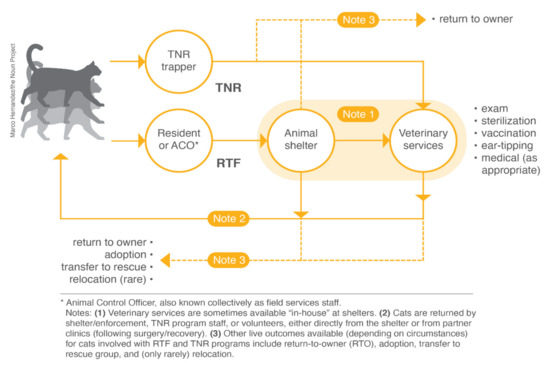
Jump to: Research
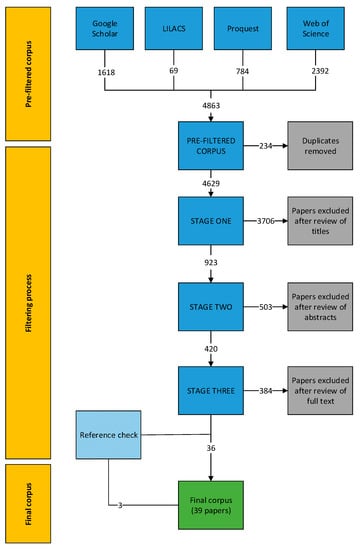
Further Information
Mdpi initiatives, follow mdpi.

Subscribe to receive issue release notifications and newsletters from MDPI journals

A stray dog rests in Brazil's Chapada Diamantina National Park. There are up to 300 million stray dogs worldwide.
Stray dogs have the natural ability to understand human gestures
The research could lead to a more peaceful co-existence between free-roaming canines—which number hundreds of millions worldwide—and people.
Humans domesticated dogs , and over our 15,000-year relationship, we’ve bred canines to be friendly and eager companions —as well as skilled at interpreting our emotions.
Now, a new study reveals even stray dogs—animals that have never lived with people—can still understand our gestures.
Up to 300 million stray dogs roam the planet, with about 30 million in India alone . These free-ranging canines often come into conflict with people, and, particularly in India, pose a public health risk as carriers of rabies, a fatal virus that kills up to 20,000 people a year in India, most of them children , according to the World Health Organization.
This has made the management of stray dogs a polarizing subject, with some people killing the animals inhumanely , says Anindita Bhadra , animal behaviorist at the Indian Institute of Science Education and Research Kolkata. Stray dogs, she adds, are never sure whether people want to feed and pet them—or hurt them.
That's why learning more about stray dogs and their behavior is crucial to resolving problems with people, says Bhadra, who has studied the animals for a decade. ( Read about the many human signals dogs can understand .)
In recent experiments, she discovered that most stray dogs knew where to look when a human was pointing to an object, suggesting their ability to read humans is innate.
The study’s findings could help educate adults and children—who are often bitten and infected with rabies while sharing food with stray dogs—how to interact with them, leading to “a more peaceful co-existence,” she says. ( Take National Geographic's dog quiz. )
Getting to the point
In the study, published January 17 in the journal Frontiers in Psychology , Bhadra and colleagues approached 160 solitary stray dogs in several Indian cities. An experimenter placed two covered bowls on the ground near them, one containing raw chicken, the other empty with just the scent of food. A second experimenter, who didn’t know which bowl was which, would then stand and point at one of the bowls, sometimes for just one second, sometimes for the length of the experiment. The hands of the second experimenter were never near the bowls.
About half of the dogs wouldn’t come close to the experimenters; many appeared anxious and had likely had negative encounters with people, Bhadra says. (Related: how your dog knows how you feel .)
Of the half that did approach, about 80 percent went to the bowl to which the second experimenter had pointed, meaning they understood the human’s gesture. If the dogs discovered that bowl was empty, they were less likely to follow the pointing cue again.
In previous studies, experimenters had been much closer to the bowls. Having the person farther away allows the canine to “judge what the humans intention is and then make a decision,” Bhadra says, as well as process new information based on whether following that cue was rewarding or not.
Overall, the study suggests that untrained dogs can relate to humans, despite likely having had traumatic experiences with them.
See pictures of dogs submitted by readers

“This is more evidence that free-ranging dogs are just as good as any other dog at using basic human gestures, and that free-ranging dogs are as smart as people often imagine,” says Brian Hare , founder and director of the Duke Canine Cognition Center at Duke University, via email. ( Read how dogs changed humans over time, too .)
Understanding stray dogs
Stray dogs are also not a recent phenomenon. The ancient Indian text The Vedas advises giving leftovers to scavengers, including stray dogs, as part of being a good householder.
While they lead tougher lives than those of house pets, strays have nonetheless adapted to us, "through the Industrial Revolution to highways, everything," Bhadra says. ( Learn how dogs know the meaning of a human smile. )
Such adaptability and resilience, as well as psychological sophistication, means free-roaming canines are not much different than any other dog, adds Hare—"and that they deserve our respect."
Related Topics
- DOMESTIC DOGS
- ANIMAL COMMUNICATION
You May Also Like

Why your dog helps you relax more than your friends do

Would your dog eat you if you died? Get the facts.

Dog DNA tests are on the rise—but are they reliable?

What’s the real difference between a mutt and a designer dog?

Meet Wicked—the very good girl who was just named America's best working dog
- Perpetual Planet
- Environment
History & Culture
- History & Culture
- Race in America
- History Magazine
- Mind, Body, Wonder
- Paid Content
- Terms of Use
- Privacy Policy
- Your US State Privacy Rights
- Children's Online Privacy Policy
- Interest-Based Ads
- About Nielsen Measurement
- Do Not Sell or Share My Personal Information
- Nat Geo Home
- Attend a Live Event
- Book a Trip
- Inspire Your Kids
- Shop Nat Geo
- Visit the D.C. Museum
- Learn About Our Impact
- Support Our Mission
- Advertise With Us
- Customer Service
- Renew Subscription
- Manage Your Subscription
- Work at Nat Geo
- Sign Up for Our Newsletters
- Contribute to Protect the Planet
Copyright © 1996-2015 National Geographic Society Copyright © 2015-2024 National Geographic Partners, LLC. All rights reserved
Widespread of Stray Animals: Design a Technological Solution to Help Build a Rescue System for Stray Animals
- Conference paper
- First Online: 22 October 2022
- Cite this conference paper

- Lianfan Wu 13 ,
- Minghui Shao 14 ,
- Shuqi Wei 14 ,
- Rouxuan Lu 15 &
- Bingdie Huang 14
Part of the book series: Lecture Notes in Computer Science ((LNCS,volume 13520))
Included in the following conference series:
- International Conference on Human-Computer Interaction
1358 Accesses
1 Citations
The issue of stray animals in cities has received continuous attention from government agencies and animal organisation around the world. However, the lack of relevant laws and regulations, as well as the lack of public service resources (e.g. funding, space and labour), poses a considerable challenge to the survival and rescue of stray animals. To address this challenge, this study attempts to optimize the current social rescue system for stray animals through a technological design solution. This study investigates and develops a rescue system of stray animal through Human-Centred Design. This research has mainly discussed around the current situation of stray animals, their causes, hazards and rescue issues. The results of this research indicate that (1) the main causes of having stray animals in cities are lost, abandoned and disorderly breeding, as well as lack of regulations. Additionally, stray animals live in poor conditions with health many problems; (2) stray animals pose a serious threat to the development of cities. There is an urgent need to optimise the stray animal rescue system at the levels of individuals, shelters and social system; (3) a technological public welfare platform would be a reliable solution to effectively improve the situation of stray animals. As a result of the research, this study designed a stray animal public welfare platform APP, which has applied big data, AI and other relevant intelligent technologies. Additionally, it solves the pain points of current public welfare rescue platforms and optimises the existing stray animal rescue process and experience, as well as make an important reference for developing the construction of a technological stray animal rescue system.
This is a preview of subscription content, log in via an institution to check access.
Access this chapter
- Available as PDF
- Read on any device
- Instant download
- Own it forever
- Available as EPUB and PDF
- Compact, lightweight edition
- Dispatched in 3 to 5 business days
- Free shipping worldwide - see info
Tax calculation will be finalised at checkout
Purchases are for personal use only
Institutional subscriptions
Kruk, E.: Polskie i estońskie uregulowania prawne dotyczące zwierząt bezdomnych (bezpańskich). Studia Iuridica Lublinensia. 30 , 145 (2021)
Article Google Scholar
Zawistowski, S., Morris, J., Salman, M., Ruch-Gallie, R.: Population dynamics, overpopulation, and the welfare of companion animals: new insights on old and new data. J. Appl. Anim. Welfare Sci. 1 , 193–206 (1998)
Reese, L.: The dog days of detroit: urban stray and feral animals. City Community 14 , 167–182 (2015)
Li, X., Dai, J.: Service design of stray cat feeding based on the theory of sustainable development. In: Stephanidis, C., Antona, M., Ntoa, S. (eds.) HCII 2021. CCIS, vol. 1419, pp. 351–357. Springer, Cham (2021). https://doi.org/10.1007/978-3-030-78635-9_46
Chapter Google Scholar
Liu, S., Chen, H.: Solving stray-animal problems by economic policies. Taipei Econ. Inquiry 54 , 1–27 (2018)
Google Scholar
Huang, Y., Chuang, T., Lai, Y.: Classification of the trap-neuter-return surgery images of stray animals using Yolo-based deep learning integrated with a majority voting system. Appl. Sci. 11 , 8578 (2021)
Wang, Z., Liu, X.: Design of animal detector based on thermal imaging sensor. J. Phys: Conf. Ser. 1550 , 042066 (2020)
USDA APHIS | Animal Welfare Act, https://www.aphis.usda.gov/aphis/ourfocus/animalwelfare/sa_awa
Act on Welfare and Management of Animals. https://www.env.go.jp/nature/dobutsu/aigo/1_law/index.html
Zito, S., Aguilar, G., Vigeant, S., Dale, A.: Assessment of a targeted trap-neuter-return pilot study in Auckland. New Zealand Anim. 8 , 73 (2018)
Boone, J.: Better trap–neuter–return for free-roaming cats. J. Feline Med. Surg. 17 , 800–807 (2015)

Kreisler, R., Cornell, H., Levy, J.: Decrease in population and increase in welfare of community cats in a twenty-three year trap-neuter-return program in Key Largo, FL: the ORCAT program. Front. Vet. Sci. 6 , 7 (2019)
Bir, C., Widmar, N., Croney, C.: Stated preferences for dog characteristics and sources of acquisition. Animals 7 , 59 (2017)
Marder, A., Duxbury, M.: Obtaining a pet: realistic expectations. Vet. Clinics N. Am. Small Anim. Pract. 38 , 1145–1162 (2008)
Reese, L.: Make me a match: prevalence and outcomes associated with matching programs in dog adoptions. J. Appl. Anim. Welfare Sci. 24 , 16–28 (2020)

Norman, D.: User Centered System Design. Erlbaum, Hillsdale (1986)
Book Google Scholar
ISO 9241-210:2019. https://www.iso.org/standard/77520.html
Carayon, P., et al.: Human-centered design of team health IT for pediatric trauma care transitions. Int. J. Med. Informatics 162 , 104727 (2022)
Termglinchan, V., Daswani, S., Duangtaweesub, P., Assavapokee, T., Milstein, A., Schulman, K.: Identifying solutions to meet unmet needs of family caregivers using human-centered design. BMC Geriatrics. 22 , 94 (2022)
Download references
Acknowledgements
This work was made possible with the support of the Wenzhou Business College which provided financial support for the subject study (XSKY20210025).
Author information
Authors and affiliations.
Wenzhou Polytechnic, Wenzhou, China
Wenzhou Business College, Wenzhou, China
Minghui Shao, Shuqi Wei & Bingdie Huang
Zhejiang University of Technology, Hangzhou, China
You can also search for this author in PubMed Google Scholar
Corresponding author
Correspondence to Bingdie Huang .
Editor information
Editors and affiliations.
Eindhoven University of Technology, Eindhoven, The Netherlands
Matthias Rauterberg
City University of Hong Kong, Kowloon Tong, Kowloon, Hong Kong
Fiona Fui-Hoon Nah
Technische Universität Ilmenau, Ilmenau, Germany
Heidi Krömker
University of West Florida, Pensacola, FL, USA
University of Central Florida, Orlando, FL, USA
Gavriel Salvendy
Rights and permissions
Reprints and permissions
Copyright information
© 2022 Springer Nature Switzerland AG
About this paper
Cite this paper.
Wu, L., Shao, M., Wei, S., Lu, R., Huang, B. (2022). Widespread of Stray Animals: Design a Technological Solution to Help Build a Rescue System for Stray Animals. In: Rauterberg, M., Fui-Hoon Nah, F., Siau, K., Krömker, H., Wei, J., Salvendy, G. (eds) HCI International 2022 – Late Breaking Papers: HCI for Today's Community and Economy. HCII 2022. Lecture Notes in Computer Science, vol 13520. Springer, Cham. https://doi.org/10.1007/978-3-031-18158-0_28
Download citation
DOI : https://doi.org/10.1007/978-3-031-18158-0_28
Published : 22 October 2022
Publisher Name : Springer, Cham
Print ISBN : 978-3-031-18157-3
Online ISBN : 978-3-031-18158-0
eBook Packages : Computer Science Computer Science (R0)
Share this paper
Anyone you share the following link with will be able to read this content:
Sorry, a shareable link is not currently available for this article.
Provided by the Springer Nature SharedIt content-sharing initiative
- Publish with us
Policies and ethics
- Find a journal
- Track your research
An official website of the United States government
The .gov means it’s official. Federal government websites often end in .gov or .mil. Before sharing sensitive information, make sure you’re on a federal government site.
The site is secure. The https:// ensures that you are connecting to the official website and that any information you provide is encrypted and transmitted securely.
- Publications
- Account settings
- My Bibliography
- Collections
- Citation manager
Save citation to file
Email citation, add to collections.
- Create a new collection
- Add to an existing collection

Add to My Bibliography
Your saved search, create a file for external citation management software, your rss feed.
- Search in PubMed
- Search in NLM Catalog
- Add to Search
Stray animals: their impact on a community
- PMID: 1124070
The statistical import of the study not-withstanding, we found the most serious problem to be the lack of understanding of the pet population crisis and compassion toward animals on the part of pet owners, as evident in the pet columns of the classified ads. Our study leads us to believe that pet owners are allowing the reproduction of kittens and puppies in such numbers that they often have no cash value and, in fact, the owners will spend money, in the form of advertising, to facilitate their disposal. The street observations indicated that relatively few animals (lessthan 1%) actually are allowed to run free. Dog bites occur at a ratio of 1:20 for the dog population. In the area under study, free roaming dogs and cats present a mild to moderate problem, originating from a small percentage of pet owners. Only a small amount of pet animal suffering occurs by death from environmental hazards (ie, automobiles), and there is just a moderate amount of intentional killing of nondersirable pet animals. We fell the method used in this study and the results obtained from it have importance elsewhere. It should be coupled with a broader based survey questionnaire to better establish the ratio of pet ownership to the general population and the reasons and benefits of pet ownership. We could then have the "facts" about the pet overpopulation problem, as well as better understand the community values toward pet animals. A complete report with additional accompanying tables is available from the senior author at Rural Route One, Urbana, Illinois 61801.
PubMed Disclaimer
Similar articles
- Effects of gender and parental status on knowledge and attitudes of dog owners regarding dog aggression toward children. Reisner IR, Shofer FS. Reisner IR, et al. J Am Vet Med Assoc. 2008 Nov 1;233(9):1412-9. doi: 10.2460/javma.233.9.1412. J Am Vet Med Assoc. 2008. PMID: 18980492
- Preventing behavior problems in puppies and kittens. Seksel K. Seksel K. Vet Clin North Am Small Anim Pract. 2008 Sep;38(5):971-82, v-vi. doi: 10.1016/j.cvsm.2008.04.003. Vet Clin North Am Small Anim Pract. 2008. PMID: 18672149 Review.
- Pet ownership in rural Northern California (El Dorado County). Franti CE, Kraus JF, Borhani NO, Johnson SL, Tucker SD. Franti CE, et al. J Am Vet Med Assoc. 1980 Jan 15;176(2):143-9. J Am Vet Med Assoc. 1980. PMID: 7353990
- Dimensions of the pet population problem. Faulkner LC. Faulkner LC. J Am Vet Med Assoc. 1975 Mar 1;166(5):477-8. J Am Vet Med Assoc. 1975. PMID: 1089622 Review.
- A survey of attitudes toward responsible pet ownership. Selby LA, Rhoades JD, Hewett JE, Irvin JA. Selby LA, et al. Public Health Rep. 1979 Jul-Aug;94(4):380-6. Public Health Rep. 1979. PMID: 572978 Free PMC article.
- Search in MeSH
LinkOut - more resources
Miscellaneous.
- NCI CPTAC Assay Portal
- Citation Manager
NCBI Literature Resources
MeSH PMC Bookshelf Disclaimer
The PubMed wordmark and PubMed logo are registered trademarks of the U.S. Department of Health and Human Services (HHS). Unauthorized use of these marks is strictly prohibited.
- DOI: 10.12834/VetIt.48.134.3
- Corpus ID: 207223888
Stray animal populations and public health in the South Mediterranean and the Middle East regions.
- A. Seimenis , D. Tabbaa
- Published in Veterinaria Italiana 1 April 2014
- Environmental Science, Medicine
11 Citations
Main challenges in the control of zoonoses and related foodborne diseases in the south mediterranean and middle east region..
- Highly Influenced
Stray Animal Population Control: Methods, Public Health Concern, Ethics, and Animal Welfare Issues
A linear regression study relating stray animal management with the importance of relative funding. a case study in a small greek city, complex epidemiology of a zoonotic disease in a culturally diverse region: phylogeography of rabies virus in the middle east, prevalence and molecular characterization of toxocara cati infection in feral cats in alexandria city, northern egypt, epidemiology of taenia saginata taeniosis/cysticercosis: a systematic review of the distribution in the middle east and north africa, molecular detection and genetic diversity of babesia gibsoni in dogs in bangladesh., bartonella infections in humans dogs and cats., canine brucellosis: insights into the epidemiologic situation in europe, low serological rate of sars-cov-2 in cats from military bases in israel, 21 references, the current status of zoonotic leishmaniases and approaches to disease control., dogs, zoonoses and public health, leishmaniasis in the world health organization eastern mediterranean region., control of zoonotic visceral leishmaniasis: is it time to change strategies, multidisciplinary collaboration in veterinary public health., environmental health in emergencies and disasters, related papers.
Showing 1 through 3 of 0 Related Papers

The internet of animals? An inside account of an ambitious plan to track animal movements across the globe
Professor of Animal Behaviour and Welfare, University of Sydney
Disclosure statement
Paul McGreevy has received funding from the Australian Research Council and RSPCA Australia.
University of Sydney provides funding as a member of The Conversation AU.
View all partners
The Internet of Animals is a clever, tempting book title and author Martin Wikelski draws us in with the promise of “discovering the collective intelligence of life on earth”. This book reflects on decades of work tracking animals, offering a vision of future technologies.
Wikelski is director of Germany’s Max Planck Institute of Animal Behavior where he and his colleagues investigate global animal migrations. They have pioneered a system for continuously remotely tracking thousands of animals, called ICARUS , short for International Cooperation for Animal Research Using Space. Their aim is to create an intelligent sensor network of animals (dubbed the “internet of animals”) and protect animals worldwide.
Review: The Internet of Animals – Martin Wikelski (Scribe)
Wikelski’s core research team has mounted an antenna on a satellite, enabling it to track various species, including vultures and toucans, with small, solar-powered trackers.
Its current ICARUS project began collecting data in September 2020. This 18-year journey depended on interactions with the European Space Agency, the European Research Council and Roscosmos (the Russian space agency).

The team’s ultimate goal is to have little GPS devices on representative samples of numerous species to reveal what decisions they make in the world, what knowledge they accumulate over their lifetimes and all the places they have been. The ambition is totally worthy even if the returns on investment so far may seem elusive to some.
Animal gatherings may catch the human eye but their biological functions can be complex. For instance, starlings may learn, from observing each other during their balletic evening murmurations, to identify individuals who have found the best feeding sites.
The ICARUS project has an impressive vision of anticipated data streams and future studies. These are largely intended to study the movements of birds and insects and may well reveal how natural hazards and human interactions affect animal populations. They should also provide data on the possible spread of plant seeds and pathogens.
Rats, cats and storks
Wikelski’s work has taken him all over the world, especially to isolated places. Time spent in isolation has clearly given him the opportunity to reflect on lessons learned from observing animals. The account of his academic journey is peppered with charming anecdotes intended to remind us what we do not yet know about animal behaviour.
These include the tale of a domestic cat he encountered, which responded to human pointing gestures, and a wild fox that spontaneously retrieved thrown sticks.
Wikelski gives names to individual animals whose behaviour lies outside the species norm. Thus we meet Hanzi, the European white stork who took a series of detours and survived a Bavarian winter only because he was cared for by a farming family, and Baby Caruso, a delightfully vocal young, male sea lion.

Details of his time spent in the Galapagos Islands are truly remarkable, allowing rice rats with negligible experience of predators to take a starring role. The author developed a fondness for these rodents. He makes a gallant attempt to remediate the profile of rats in general although he had to accept these rats would merrily eat through his tent and occasionally bite his buttocks.
A secondary purpose of this tale is to illustrate the rats’ extraordinary homing ability. When one annoying rice rat was relocated a 20-minute walk away from Wikelski’s campsite, it turned up within a couple of hours of departure.
Homing behaviour in various species lends itself to tracking because of its predictability. It has provided an excellent test-bed for telemetry – the remote collection and automatic transmission of data to receiving equipment for monitoring.
The conclusions Wikelski draws from these fascinating observations may alarm those who have been sensitised to anthropomorphism, but they have merit. In keeping with its call for humility on the part of conventional scientists, his book also acknowledges how many First Nations people have drawn on the behaviour of animals to inform strategies for their survival.
Technical questions
Wikelski has developed transmitters small enough to be carried by dragonflies. This deserves praise from a technological perspective but leaves the reader wondering how many animals were impacted by being captured and fitted with prototypes.
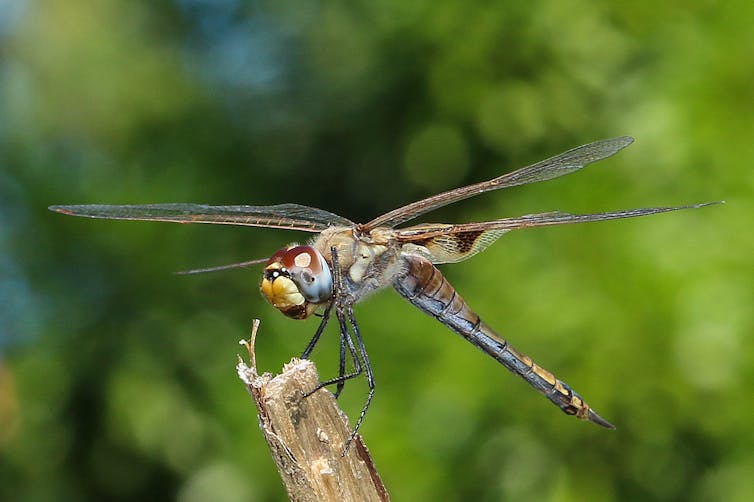
We are told birds adjust their own body-weight to accommodate the centre of mass of the tiny transmitters used by Wikelski’s team. In a similar vein, 6-inch (15 cm) long antennae were used on blackbirds even though they projected beyond the tail-feathers. This specification was required for transmission to the satellite but one wonders how authentic the resultant data are when birds are moving with the burden of a foreign body occupying space immediately around them.
Also, Wikelski and many other telemetrists’ use of collars limits research to adult animals because radio collars sized for young wearers become too tight as the animal grows.
Furthermore, as it ages, the epoxy above the solar panel on a tracker can become cracked and grey. This can mean charging is compromised. Meanwhile, the base of the housing touching the back of the animal may be too rough and may damage the pelage or plumage or even the skin of the wearer.
The sixth sense?
Wikelski anticipates the next waves of wearable tracking technology will reveal the sixth sense animals are often said to have. For instance, in apparent anticipation of earthquakes, elephants will travel to higher ground.
In animal behaviour circles, revealing this sixth sense and its true nature is akin to the search in physics for gravitational waves or the Higgs boson particle.

We are introduced to Move Bank , an open source archive of the movement of animals across the planet. Resources such as this help to reveal the costs of migration in songbirds (for example, how much energy is being used or the risk of being eaten by predators, or being exposed to dangerous weather systems) and how migrations trend over time . Move Bank was established 25 years ago to help animal tracking researchers manage, share, protect, analyse and archive their data.
Since then Move Bank has been the source of hundreds of research articles but Wikelski gives us a sense of how vulnerable “blue-sky” science projects are to the whims of government and the global economy. Who knew pandemics and wars could also disrupt the best laid plans for international research collaborations?
In a twist of fate, the ICARUS project eventually went live on 20th March 2020 at almost the same time the global COVID pandemic started. This meant human activity on the globe shut down – the so-called anthropause . Fortuitously it meant animal movements could be studied with a minimum amount of human impact.
In the wake of the pandemic, the prospects of using animals’ GPS locations to monitor the spread of zoonotic disease is truly beguiling. For instance, all countries should be interested in the migration of wild birds given its clear relationship to the spread of avian flu.
The collegiality and tenacity multidisciplinary teams require for intercontinental tracking of animals are celebrated in this book and the author demonstrates great humility in listening to technicians and senior authors from related disciplines. The call for greater collaboration among competing research groups is loud and clear.
But Wikelski leaves us in no doubt his discipline’s dependence on satellite tracking has been characterised by serial frustrations. The war on Ukraine has meant the International Space Station is no longer available to host the key tracking satellite involved in the ICARUS Project. (We are told only one receiving device could be made – and mounted – on the satellite.)
Instead, from late 2024, the transmitters fitted to the animals will transmit their position and other data to a receiver on a mini satellite ( a CubeSat ). From there, the data will be sent to a ground station and published in the Movebank database, which is freely accessible.
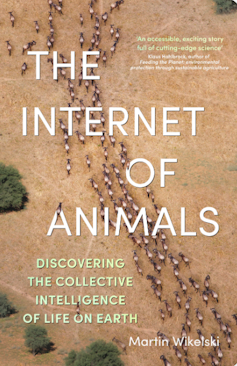
A great deal of research work thus hinges on single items of technology. Nevertheless, Wikelski’s book ends with a veritable shopping list of anticipated research projects.
We are reminded that the “internet of animals” is still in its infancy. But this doesn’t stop the author envisioning what he calls a daily life-cast (not weather forecast) about our planet and the animals in it. He even foresees modern technology allowing a representative online “parliamentary gathering of animals” in which thousands of species can be monitored in the wild by individuals all over the world.
This process of witnessing endangered animals in the wild, he suggests, would be linked to an animal protection payout system levied on the world’s wealthiest people, ensuring their habitats were cared for by local peoples. This, we are assured, would mean animals were no longer persecuted by humans or disadvantaged by decisions we make to further our own lives.
- Book reviews
- Animal behavior
- Animal tracking

Social Media Producer

Student & Academic Services Officer

Dean (Head of School), Indigenous Knowledges

Senior Research Fellow - Curtin Institute for Energy Transition (CIET)

Laboratory Head - RNA Biology
Stray dogs in urban fragments: Relation between population's perception of their presence and socio-demographic factors
- January 2018
- Pesquisa Veterinária Brasileira 38(1):89-93
- 38(1):89-93
- CC BY-NC 4.0

- University of São Paulo
- This person is not on ResearchGate, or hasn't claimed this research yet.

- Ministério da Saúde do Brasil
Abstract and Figures

Discover the world's research
- 25+ million members
- 160+ million publication pages
- 2.3+ billion citations

- Yasmin da Silva Gonçalves da Rocha
- Mariana Ulanin

- ENVIRON ECOL STAT

- Leonice Seolim Dias

- Karina Andrade Mattos
- Cecilia Evelina
- Nina Carina

- Michelle Stephanie Rojas Miñan
- Juan Jhair Rodríguez Dávila

- Urban Ecosyst

- Appl Anim Ethol
- Hildy D. Rubin

- Jennifer M Scarlett
- J M Hutchinson
- Oswaldo Santos Baquero
- L.A. Akamine
- Marcos Amaku
- F. Ferreira

- Mauro Riegert Borba
- Mark Stevenson
- Aline H. Kidd
- Robert M. Kidd

- Thomas J. Daniels
- Recruit researchers
- Join for free
- Login Email Tip: Most researchers use their institutional email address as their ResearchGate login Password Forgot password? Keep me logged in Log in or Continue with Google Welcome back! Please log in. Email · Hint Tip: Most researchers use their institutional email address as their ResearchGate login Password Forgot password? Keep me logged in Log in or Continue with Google No account? Sign up

- What Animal Studies Are Revealing About Their Minds—and Ours
N ever underestimate the mind of a crow. Members of a family of birds that includes ravens, rooks, magpies, and jays, crows have been known to bend wire into hooks to retrieve food; drop nuts in a road so passing cars will crack them open; and recognize humans who have posed a threat, harassing them on-sight even months after their first encounter. But some of the smartest crows of all may be found in the animal physiology lab at the University of Tübingen in Germany. It’s there that the birds are mastering a skill you couldn’t manage until you were up to 4 years old: counting.
In a new study published in Science , researchers trained three crows to emit one to four caws in response to seeing the numbers 1, 2, 3, or 4 projected on a screen. The birds also learned to count out the proper number of vocalizations when cued by sounds, with a guitar chord eliciting a single caw, a cash register eliciting two, a drum roll signaling three, and a frequency sweep calling for four. In doing so, the birds matched or beat the numeracy skills of human children who often don’t master rudimentary counting until kindergarten.
Says animal physiologist and study co-author Andreas Nieder : “When faced with a set of three objects and asked, ‘How many?’ toddlers recite the speech sounds ‘one, two, three’ or even ‘one, one, one.’ We show that crows have the ability to count vocally [too].”
And crows aren’t the only creatures that understand simple math. Similar skills have been observed in studies of comparatively intelligent animals including gorillas, dolphins, elephants, the rhesus macaque, and the squirrel and capuchin monkeys. Even the less-clever rat can fathom basic arithmetic, with a recent study in Science Advances showing that the animals can be trained to hear two or three tones and then press a button corresponding to one number or the other. The learning didn’t come easy: It took two months for the rats to make that distinction, but it was the fact that they could do it at all—not that they were slow on the uptake—that was the true news.
The last few months alone have been something of a boom time for research into the intelligence and behavior of animals. German researchers discovered a sort of pre-verbal stage in finches —similar to the babbling stage in humans—that leads to their becoming fluent in song. Studies in Sweden and Vienna explored the role of play among barnyard chicks and a species of falcon. French researchers studied advanced use of sticks as tools in chimps , and other work in the U.S. made similar findings among otters . And perhaps most remarkably, researchers in Indonesia published a study about a wild orangutan, nicknamed Rakus by the scientists, that was observed chewing the leaves of a plant with known medicinal and analgesic properties and applying the resulting pulp to a wound on its face.
“It may be that Rakus learned this behavior from other animals in his birth area,” says lead author and animal behaviorist Isabelle Laumer of the Max Planck Institute in Germany. It is also possible that he came upon the discovery on his own, she says, accidentally applying the plant juice to himself by touching his wound while feeding on the leaves. “Rakus may have felt immediate pain release, causing him to repeat the behavior several times and subsequently apply solid plant matter,” adds Laumer.
All of these studies and more have implications not just for our understanding of animals, but for our understanding of ourselves, as creatures with often-similar brain structures. In one European study , researchers pinpointed twin regions in the human brain that allow us to recognize emotions in other people’s faces, and found corresponding regions in the brains of mice, raising the possibility that one of our most sophisticated traits—our ability to read the minds and moods of others—might be distributed throughout the animal kingdom.
“These evolutionarily conserved mechanisms should be common in most mammals,” says Francesco Papaleo, senior researcher at the Instituto Italiano de Tecnologia in Genoa, Italy, and a co-author of the study. “Properly recognizing and appropriately responding to altered emotions in others is essential for survival.”
The play is the thing
Of all of the recent research, it is the studies that explore play that illustrate the most engagingly ingenuous side of animals. Domestic chickens may be nobody’s idea of a personable species, but a May study in Frontiers of Ethology observed extensive play behavior in young hatchlings, especially males. Investigators raised the chicks in relatively spartan cages and then periodically transferred them to playpen areas with other chicks, aged from 6 to 53 days. In the presence of the rest of the flock, the males engaged in a wide range of play behaviors—all in sight of females—including frolicking, wing-flapping, jumping, and sparring. When the researchers introduced a rubber worm into the pens, the nearest male would pick it up and scurry around with it. Known in the wild as worm-running or tidbitting, the behavior, which can involve other forms of food as well, is an apparent display for the benefit of the females—a means of impressing them with the male’s resource-gathering skills.
“We still don’t know the adaptive function of play for any species,” said Per Jensen, professor of ethology at Linköping University in Sweden and a co-author of the study, in a statement. “However the present study indicates that a possible function is to prepare animals for specific challenges they may encounter later in life. In a species like the chicken, where only males compete for territories, it makes sense that they engage in more social play as young.”
Falcons display similar behavior for equally practical reasons. A February study in the Journal of Raptor Research documented the Falkland Islands species known as Striated Caracaras routinely engaging in play with sheets of plastic, sea cabbage, stones, and even sheep dung. To qualify as play, animal and human behavior has to meet several criteria, including being voluntary and repeatedly performed, appearing intrinsically rewarding, and lacking apparent purpose. But appearances notwithstanding, there may be decidedly practical functions to play.
In the case of the falcons, which live in a place in which food resources are more available in some seasons than in others, playing with objects might reveal an unexpected nutrient source. “The more caracaras interact with the world around them, the more opportunities they have to learn what is food and what isn’t,” said study co-author and behavioral ecologist Katie Harrington, of the University of Veterinary Medicine in Vienna, in a statement.
Animals, including homo sapiens, also play to practice combat, hunting, mating, and territorial claims, all of which are needed later in life. “That we see play in so many different species—including humans—tells us that it’s a really important component of our behavioral repertoire,” adds Harrington in an email to TIME. “We tend to see age differences, where younger individuals play more than older individuals. Studying the diversity of play can help us learn how and why it developed to be so important.”
The canine mind
Far and away the most studied animal mind in the world may belong to the domestic dog, if only because, with 471 million pet dogs worldwide, every home becomes something of a real-time, real-world behavioral lab. Still, it is the formal, peer-reviewed research that produces the most rigorous findings, and there is no shortage of that work. In one May study published in Animal Behaviour , investigators from the University of Helsinki subjected 987 dogs to various tests of behavior and problem-solving skills, looking for the traits such as impulsiveness, persistence, independence, and willingness to turn to humans for assistance, which help dogs function better either as working animals, domestic animals, or both.
In one test , the dogs were shown a short, clear cylinder containing a treat that was accessible only by an opening at either end of the container rather than through its transparent but impenetrable middle. The fewer times a subject dog mouthed the closed part of the cylinder before turning to the open end, the higher it scored. Another, similar test placed a treat behind a clear, V-shaped wall that required the dog to detour around the barrier, rather than simply bumping up against it in an attempt to get at the reward. A third test placed a treat inside a clear, locked box that was impossible for the dog to open—measuring how persistent the animal would be before giving up and turning to a human for help. A little persistence is considered good. Too much suggests a lack of learning curve.

On the whole, says Saara Junttila, doctoral researcher with the university’s faculty of veterinary medicine and lead author of the paper, dogs with lower inhibitory control were good problem solvers and excelled in working roles and in canine sports, but were less tractable and trainable in the home.
“As an example, the Belgian shepherd Malinois was one of the fastest breeds at solving the V-detour task, and this breed spent a lot of time trying to solve a problem independently rather than looking at a human. [But it] is considered to be a more challenging breed [to train],” Juntilla says. “Other breeds such as the golden retriever may be more suitable for the role of pet dog, as they turn to humans during a problem-solving situation and have higher inhibitory control.”
The findings have implications not just for canine behavior but for humans, too. Some researchers have found parallels between attention deficit hyperactivity disorder (ADHD) in people and similar distractibility and impulsiveness in dogs.
“Our results do seem to indicate that ADHD-type traits occur together,” says Junttila. “We found that dogs with low inhibitory control were more impulsive, less trainable, and had higher activity levels. People with ADHD [also] often have lower inhibitory control, impaired academic success, and higher impulsivity and hyperactivity.”
Dogs and people overlap in other ways, too. In one recent study published in Biologia Futura , investigators found that dogs that had been trained to imitate human behavior—such as turning or sitting or nodding their heads—do not need the cues to be delivered only in person, but could also obey them when simply seeing an image of a person on a computer screen. The dogs were better at imitating behavior when they saw the human from a perspective with which they were familiar—from the front or the side, for example, as opposed to from above. But either way, the investigators saw significance in the ability of the animals to make the leap that a two-dimensional image was effectively equivalent to a three-dimensional person.
Says lead author Claudia Fugazza, professor of ethology at Eötvös Loránd University in Budapest: “In general, dogs seem to be able…to extract the relevant information from 2D projections and use it to act appropriately in the 3D, real life context.” The findings have meaning that go beyond canine parlor tricks, opening up the possibility of virtual human-dog communications, serving to entertain the animals and provide emotional support to human companions.
Tooling about
The ability to use even simple tools was once seen as a talent limited to humans. Research has long since upended that belief, with studies showing a range of tool use among animals, including orangutans , which create whistles out of leaves to chase away predators; dolphins , which use marine sponges to scour the seafloor and stir up prey; and even the degus , a chinchilla-like rodent, which can be taught to use small rakes to look for food. New research is now turning up insights into the talents of one of nature’s most prodigious tool-users—the otter—with findings suggesting that the female of the species outperforms the male in this sophisticated skill.
The otters’ most common tool is a rock, which the animals use to crack open abalone shells to get to the tender meat inside. In a new study in Science , researchers from the University of Texas, Austin, and elsewhere observed 196 radio-tagged sea otters off the coast of California and discovered that the animals were using other tools as well—including shells and hard trash—to break open their prey. Females generally employed a wider array of tools than males did, an innovation they arrived at by necessity, as their smaller size and somewhat weaker jaws make cracking or biting open prey harder. Not only does more sophisticated tool use spare them tooth damage that they might otherwise sustain by trying to bite prey, it also provides them greater energy needed to raise and feed pups.
Chimps too are even better at tool use than commonly understood. The animals are most famously known for their ability to use twigs stripped of leaves to fish into small openings in logs and extract termites as food. New research in PLOS Biology found that this is not a static talent, but rather one that the animals improve throughout their lives, learning to fish for the insects by age 2 or so, and steadily improving their grip and eye-hand coordination over the years.
“The most efficient grips and actions to hold and manipulate stick tools continue to develop at least until [age] 15 [and] well into adulthood,” says lead author Mathieu Malherbe, primatologist with the Max Planck Institute in Germany.
This means war
Not every new trait animals exhibit is a noble one—a fact that is borne out by a recent study of bonobos. Colloquially known as the hippie chimp, for their generally peaceable ways and their matriarchal social structure, the great ape species turns out to be a lot more aggressive than thought, at least when it comes to male-on-male violence. Writing in the journal Current Biology , researchers from Harvard University found that male bonobos actually engage in three times the amount of mano-a-mano combat than their more warlike cousin, the chimpanzee. But the reason for the difference is paradoxical.
On the whole, chimps are significantly more violent as a group than bonobos, with bands of males engaging in sometimes mortal combat with other bands over access to food, territory, and females. This makes it essential that bonds within each tribe remain close—ensuring that the group presents the most united front when facing other tribes. Bonobos, which do not engage in organized warfare, can afford more squabbling and friction within the group without making themselves vulnerable to outsiders.
“The most likely causes of male aggression [among bonobos] are over who gets to stay in a feeding tree or at a good feeding spot,” says Martin Surbeck, assistant professor of human evolutionary biology at Harvard and a co-author of the study. “Chimpanzees depend on each other and thus have a lot of incentive not to make a fuss out of each potential conflict, while the individualistic nature of bonobo society makes aggression just way less costly and more frequent.”
The lovable scavenger
If the Striated Caracaras falcon is known for play, its cousin, the Chimango Caracaras, is developing a reputation for domestic bliss. In another study in the Journal of Raptor Research, investigators found elaborate co-parenting behavior between male and female pair-bonded birds. Among most species of raptors, the larger female incubates the eggs and defends the nest while the smaller male hunts for prey. Male and female Chimango Caracaras, however, which are scavengers, show little difference in size, and thus share responsibilities for gathering food as well as caring for the young.
A team led by PhD candidate Diego Gallego-Garcia of the Center for the Study and Conservation of Birds of Prey in Argentina studied 70 of the species’ nests and observed incubation, brooding, and food delivery responsibilities being evenly shared by both parents. The male and female alike also showed an understanding of the chicks’ needs throughout the day—brooding them more in the morning when temperatures were lower, for example. It is the species least lovely trait—its carrion diet—that contributes most to such an egalitarian household.
In raptors that kill live animals, says Gallego-Garcia, smaller males bring prey to the nest, but do not feed the chicks, relying on the larger female to “chunk the food” into bite-sized pieces. This, he says, “ties the female to the nest and prevents it from leaving to hunt. However in scavenger species, since carrion is usually brought as pieces of raw meat, it is more manageable for nestlings. This way the female is free to leave the nest and hunt, allowing for the biparental care that we observe.”
The balanced home is an animal grace note—one of a great many across both the human and the non-human world. “The case of the Chimango Caracara is rare among raptors, but is a general rule in most other birds, and not uncommon in mammals,” says Gallego-Garcia. “This reinforces the idea that, in these cases, both members of the couple are necessary for the successful rearing of the offspring.” As it goes in animals, so it goes in us.
More Must-Reads from TIME
- Melinda French Gates Is Going It Alone
- Lai Ching-te Is Standing His Ground
- Do Less. It’s Good for You
- There's Something Different About Will Smith
- What a Hospice Nurse Wants You to Know About Death
- 15 LGBTQ+ Books to Read for Pride
- Want Weekly Recs on What to Watch, Read, and More? Sign Up for Worth Your Time
Write to Jeffrey Kluger at [email protected]
Hakai Magazine
Coastal science and societies, other ways to engage with hakai magazine.
- Sign up for a weekly newsletter
- Audio edition
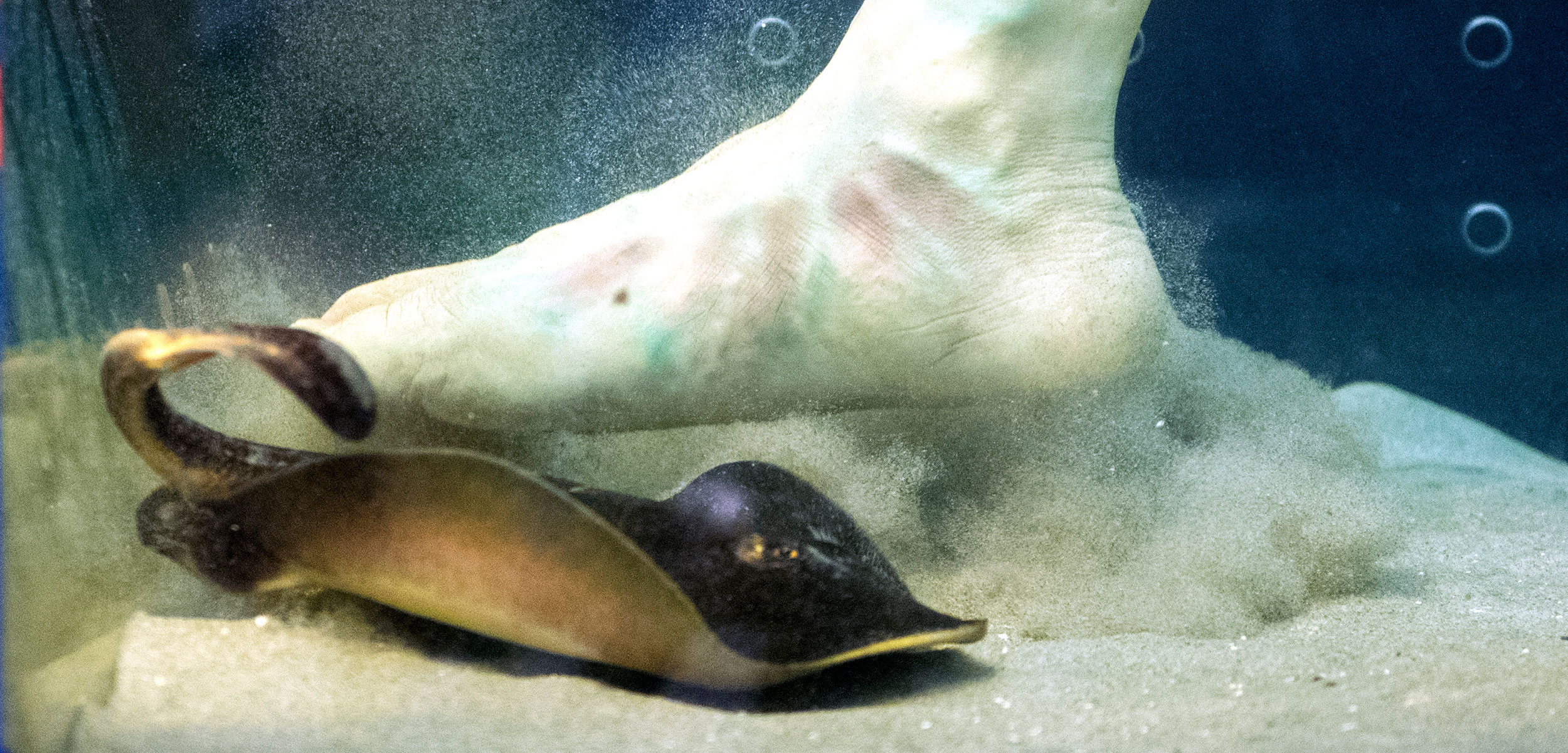
A Step Forward in Stingray Science
A california researcher and his team simulate stepping on round rays to learn more about how, why, and when the animals strike., authored by, article body copy.
Stingray 12 is surprisingly calm for an animal that’s getting squeegeed. The ray, roughly the size of a dinner plate, is submerged in the sand of a tank about the size of a chest freezer; even the golden eyes on top of her head are buried in the sediment. She stays motionless as researcher Ben Perlman of California State University, Long Beach, (CSULB) carefully pushes the sand from her mottled-brown body—the squeegee offering the scientist a little protection from the hazardous-looking barbs poking out halfway down Stingray 12’s tail.
“Sorry to bother you,” Perlman murmurs.
Six undergraduate students peer over his shoulder, and one, Carly Brenner, steps forward holding a 3D-printed silicone human foot glued to a PVC pipe.
“A little closer, a little closer,” Perlman coaches, as Brenner brings the foot centimeters from the stingray’s body. “Go for it,” he says, and Brenner takes aim at the stingray’s left pectoral fin, stamping down with the flexible foot.
The ray doesn’t move at all.
“No response,” Perlman says. The result will be logged into his lab’s study of what makes stingrays attack—science that Perlman hopes will eventually help people avoid painful stings from the serrated barbs, each about the length of an adult human’s big toe.
Perlman’s lab in Long Beach, California—aptly called STABB, for Stingray and Butterfly Biomechanics Lab (the butterfly project is currently paused)—explores how and why stingrays move and behave the way they do. Seal Beach, one of the city’s popular surf spots, five kilometers from the lab, is colloquially known as Ray Bay. Stingrays love to congregate there in the calm, warm waters at the mouth of the San Gabriel River, and lifeguards document upward of 500 painful stab injuries from rays each year. Studying the rays’ behavior and their stinging process can open a new window into human interactions with what the lab calls “danger pancakes,” Perlman says.
His research focuses on round rays —the most abundant ray species inhabiting California’s waters. Their behavior also makes them the most dangerous to unsuspecting passersby. While other rays quickly flee at the hint of danger, round rays stay buried in the sand and even hold their breath as a predator such as a juvenile great white shark—or a perceived predator such as a human—goes by, relying on their mottled color for camouflage. It’s this protective behavior that makes them far more likely to get stepped on and explains why the vast majority of stingray injuries in California are attributed to round rays, rather than the bat rays or diamond stingrays that also live in the area.
Stingray barbs are a kind of dermal denticle—like a tooth—on a tail that can be whipped around. In a strike, the animal releases a toxin from glandular cells at the base of one of the barbs. The toxin travels along a mucous coating and gets envenomated—injected—into the recipient through the puncture wound. Some ray species have barbs with serrated notches, which can make the barb stick into the skin of their attacker.
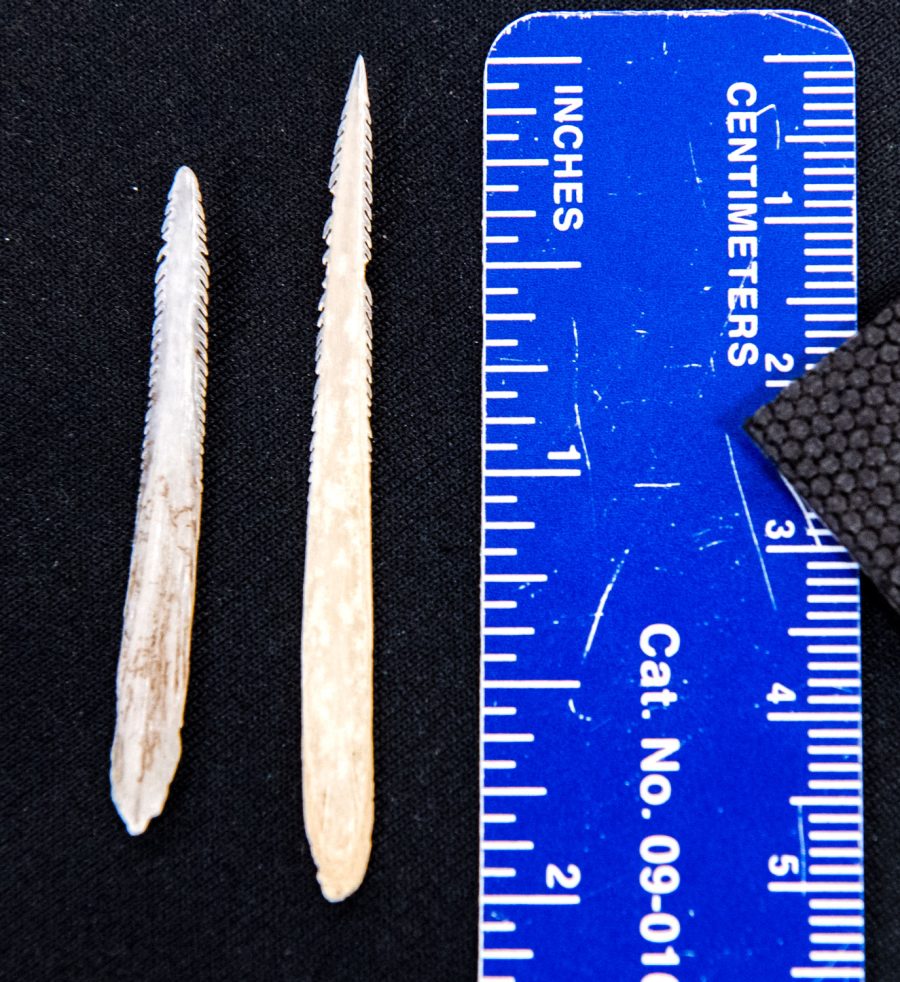
The serrated edge of a stingray’s barb can puncture and cling to a person’s skin. Photo by Thomas R. Cordova/ Long Beach Post
Chris Lowe, a shark biologist who leads CSULB’s Shark Lab , estimates that about 10,000 people per year are injured by stingrays in Southern California. Round rays are like burger patties for juvenile white sharks, which is one of the reasons Lowe and his fellow shark scientists are keenly interested in stingray distributions and populations. The Shark Lab, established in the 1960s, has studied stingrays for years, but never their stinging mechanics.
Perlman, meanwhile, didn’t set out to research rays—he’s a fish biomechanist who studied how surfperch swim in kelp forests and how amphibious fishes in the tropics use their muscles to haul themselves out of the water. He also studied how birds’ wings can shapeshift during flight and how bullfrogs load up their tendons to increase their jumping power. In 2018, he took a job with CSULB as a teaching professor and left research for a few years.
Then, he got a knock on his door in the fall of 2021. Lowe had a question. He wanted to know if Perlman could help test a new material for surf booties developed by an inventor whose kids were afraid of rays, and a collaborator with expertise in materials science. Would the booties protect against stingray strikes, as designed? After receiving funds from an anonymous, surf-loving donor, Perlman hired a student, and together they collected rays from Seal Beach to serve as their test subjects.
To figure out if the material could protect against strikes, Perlman first had to understand the dynamics of the stingray’s defensive behavior. His initial research goal was to capture strikes on camera and use the footage to measure velocity and acceleration, which he could then use to calculate force. He bought a disembodied foot from the store Spirit Halloween, filled it with sand, and epoxied it onto a piece of plastic pipe to mimic a human foot for the trials. “That was a great jumping-off point,” Perlman says.
To learn more about what makes a ray decide to strike, he designed an experiment that divides the ray’s body into four different regions—midbody, left pectoral fin, right pectoral fin, and snout (basically equivalent to a nose). His team uses the zombie foot—which was upgraded to a 3D-printed silicone foot in 2023 because it’s more realistic—to “step” on the different parts of the body and record the animal’s reaction.
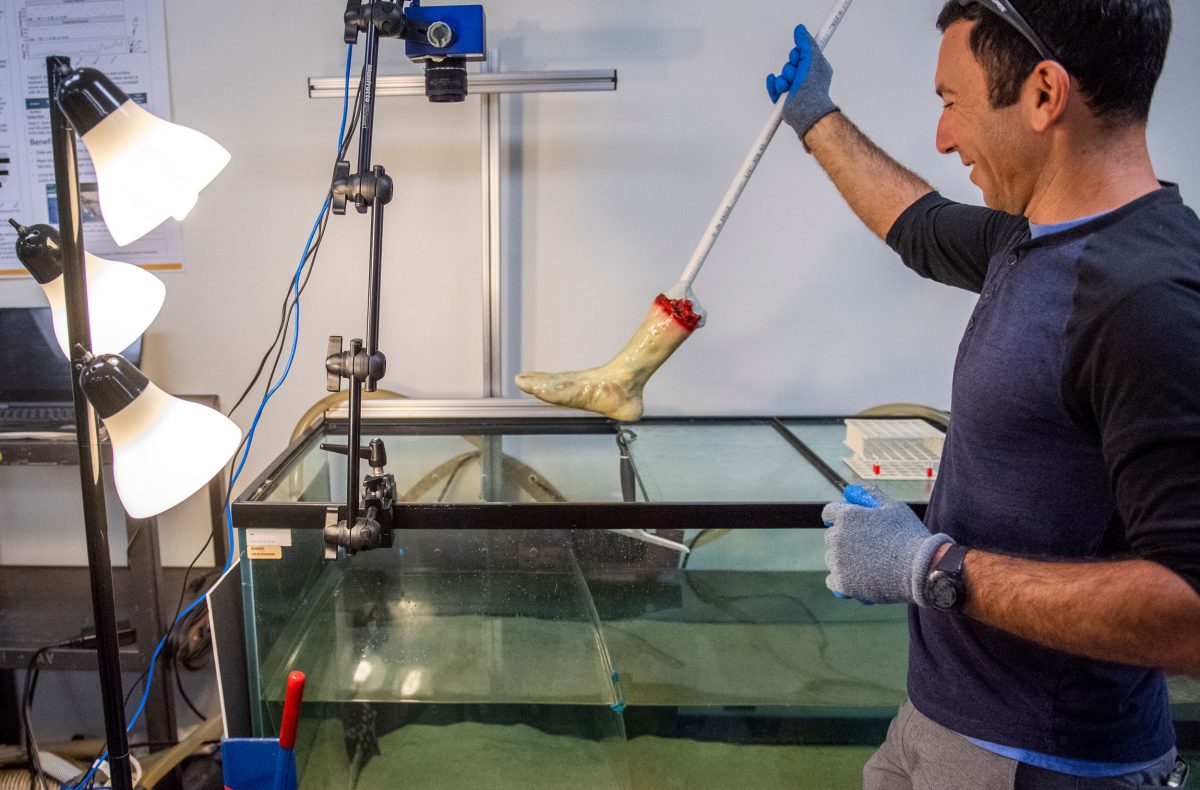
Ben Perlman started his experiments on round ray strikes using a Halloween zombie foot. He has since upgraded to a 3D-printed model. Photo by Thomas R. Cordova/ Long Beach Post
The initial findings are stark: rays only strike if someone steps on their midbody, where all their organs are located. That makes them strike 85 percent of the time. Stepping on their sides just makes them swim away; a bop on the snout doesn’t elicit a reaction either. The findings are consistent, regardless of the ray’s size, age, or sex.
The lab has also been doing studies of the new material Lowe brought to Perlman—neoprene with a rubber composite lining—to see if it can stand up to the forces of a stingray strike. The researchers clip off barbs—akin to cutting off a fingernail, since the keratin-based barbs regrow within a few months—and use a machine to force them into the material with increasing pressure. So far, they have found the material to resist the force of most stingrays. (Another company hoping to create a ray-proof bootie is spinning out a product using a similar material this year.)
In addition to their barbs, some stingrays have large, thorny, scale-like denticles that provide passive protection, says Chris Martinez, a fish biologist at the University of California, Irvine, who studies stingray morphology. The thorns can pierce skin and make a predator’s life unpleasant, he says, but the stinger is something extra: a targeted weapon the animal can actively control to inflict damage.
Martinez says Perlman’s work is “really great and it’s definitely very relevant to cater to Southern California beachgoers.” He is planning to collaborate with Perlman in the future to investigate the neuromuscular underpinnings of the strikes.
The ultimate hope, Perlman says, is that the research will translate into best practices for people at the beach. For decades, surfers in Southern California have used a technique called the “stingray shuffle,” where they take tiny steps along the ground instead of big steps—to warn stingrays who might be buried in the sand.
Perlman says his experiments have scientifically backed up the stingray shuffle—when someone takes tiny steps, they are not going to come into contact with the midbody section of the ray, so they won’t be struck. Vibrations through the sand can also give the animal a chance to move to safety. “[The rays are] just going to escape or not respond,” Perlman says.

Perlman walks with student Trinity Lozano as she transports a ray between tanks. Photo by Thomas R. Cordova/ Long Beach Post
He knows exactly what’s at stake. Last summer, he was holding down a ray’s tail with a net while using a scalpel to make small identifying notches on the animal’s body—which has to be redone every few months as the notches grow out—when his hand slipped and the fish’s tail whipped around and struck an artery on his wrist. Blood immediately squirted everywhere, and the pain was “a seven-and-a-half out of 10.” He used the only known treatment, which was to submerge his hand in hot water to denature the poison. It took nearly two hours for the pain to fade. His wrist still bears a scar.
The lab is now engaged in a flurry of research activity that can keep Perlman and his teammates busy for the rest of the decade. They are testing how the size of a foot impacts the likelihood of a stingray strike, to see if someone who is lighter and smaller is less likely to get stung. So far, foot size seems to have no impact on how a ray responds. In the coming months, they’ll repeat the stepping experiments in the dark and in different water temperatures. The lab is home to 18 rays, and the animals get at least two days off between experiments to make sure they don’t get conditioned.
The researchers are also in the midst of studying rays as they bury themselves in the sand to understand why and how the animals move sand particles around. Eventually, the lab will also use 3D imaging from microCT scans to look at the curvature, sharpness, and angle of serrations across different round ray barbs. That will help them understand variation within the species and even within an individual: sometimes, after being clipped, a barb will grow back in a different shape or size.
Sharks tend to loom larger than rays in the Californian consciousness, Martinez says. “Rays don’t get as much attention because they’re not as big, they don’t have the big teeth like some of the large sharks do,” he says. “But you’re more likely to be harmed by one of those than a big shark.” The stats prove his point: in 2022, 57 shark attacks occurred around the globe, and stingray injuries were likely in the tens of thousands.
After her encounter with the silicone foot, Stingray 12 gets a 10-minute break before her other pectoral fin is stepped on. Perlman watches as she buries herself back in the sand. It feels good to take a figurative step toward helping fellow Californians avoid stabs and stings, he says. Ultimately, if surfers and swimmers can use his research to avoid danger pancakes, everyone’s time at the beach—rays included—will be more harmonious.
Related Topics
- Living Things
- People & Society
- North America
- Pacific Ocean

The Secret to Setting Goals
Winning in the Workplace
- Find a Therapist
Verified by Psychology Today
- Psychiatrists
- Treatment Centers
- Support Groups
Professionals
Therapists Sign Up | Login
Psychology Today: Health, Help, Happiness + Find a Therapist
Today’s essentials today’s essential reads.

Adolescence
5 life lessons for my son before he leaves for college.
Steven C. Hayes Ph.D. on June 18, 2024 in Get Out of Your Mind
Young adulthood is about challenging yourself and discovering who you are. These lessons will serve as a guide along the way.

Law and Crime
What is that dog doing in the witness box.
Stanley Coren PhD., DSc, FRSC on June 18, 2024 in Canine Corner
Therapy dogs to comfort stressed witnesses in court has not gone unchallenged.

- Relationships
The Crisis of Romantic Knowledge
Aaron Ben-Zeév Ph.D. on June 18, 2024 in In the Name of Love
An abundance of romantic options facilitates finding a romantic (and sexual) partner with ease but is an obstacle to maintaining enduring, profound romantic relationships.

Sniff Test: Research Is Unraveling The Mysteries of Smell
Noam Shpancer Ph.D. on June 17, 2024 in Insight Therapy
Smell is more important than you think. A recent research review debunks myths about our sense of smell and highlights the power of olfaction.

Sex Lives of Straight Young Men
Ritch C. Savin-Williams Ph.D. on June 18, 2024 in Sex, Sexuality, and Romance
Most men have first sexual intercourse by the one-year annual anniversary of high school graduation. The consequences of first sex range from exuberant to disaster.

Social Life
How do we decide to leave a social interaction.
Patricia Lockwood, Ph.D., and Jo Cutler, Ph.D. on June 18, 2024 in The Helpful Brain
When should we leave a social interaction? Decisions to stop interacting are influenced by the environment we are in and whether people treat us fairly.

June Is Migraine Awareness Month: Take Advantage
Kathleen O’Shea on June 18, 2024 in So Much More Than a Headache
During Migraine Awareness Month, think about ways to educate others about migraine. What can you do on a personal level?

Why People Stay in Terrible Relationships
Sarah Epstein LMFT on June 18, 2024 in Between the Generations
If a relationship is awful, why don't they just leave? As it turns out, it is not that easy.

Young Men’s Greatest Risk Factor for Erection Problems
Michael Castleman M.A. on June 18, 2024 in All About Sex
Recent pooling of the results of many studies shows that young men's top risk factor for erectile dysfunction (ED) is migraine headache.

LLMs and the Shadow of the Divine
John Nosta on June 18, 2024 in The Digital Self
LLM, as reflections of human cognition, blur the boundaries between artificial and human intelligence, inviting us to ponder the nature of consciousness and creation.

3 Ways That Mothers Fall Victim to "Mommy Drinking Culture"
Mark Travers Ph.D. on June 18, 2024 in Social Instincts
The next time you hear "Mommy needs a drink," recognize it as a call for help.

It's Never Too Late to Heal the Pain of the Past
Samuel L. Pauker, M.D., and Miriam Arond on June 18, 2024 in Depression: A Guide for the Perplexed
I've seen, over and over again, that it's never too late to work through, reframe, and overcome painful parts of one's past.

Not Getting Much From Therapy? Could You Be in Pretend Mode?
Jennifer Gerlach LCSW on June 18, 2024 in Beyond Mental Health
Could you have the same conversation you are having with your therapist with an imaginary friend? If so, you might be in pretend mode.

Was Your Marriage Over Before It Began?
Lindsay Weisner Psy.D. on June 18, 2024 in The Venn Diagram Life
Marriage ends long before one may be ready to admit it.

The Solutionary Way: How to Do the Most Good and Least Harm
Marc Bekoff Ph.D. on June 18, 2024 in Animal Emotions
In her new book, Zoe Weil explains how to end societal systems that cause suffering. Her methods promote a mindset and practice for problem-solving in our communities and world.

Mind the Gap: Bridging the Intergenerational Divide at Work
Gil Winch Ph.D. on June 18, 2024 in Caring Leadership
Workplaces today may have teams with age differences of 40 years or more, creating potential generation-gap issues but also opportunities to enhance fun and engagement.

9 Lessons on Effective Leadership from Man’s Best Friend
Llewellyn E. van Zyl Ph.D. on June 18, 2024 in HappyBytes
What lessons can dogs teach us about effective leadership?

Sensation-Seeking
The safety in risk-taking.
Robert N. Johansen Ph.D. on June 18, 2024 in A New GPS for Intimate Relationships
The risks we take define who we are and what we achieve. This is especially true within our closest relationships where managing our needs and feelings can be challenging.

I've Met the Bear, and I Would Still Choose It
Patricia Prijatel on June 17, 2024 in All Is Well
Personal Perspective: In the "Man vs. Bear" debate, neither choice feels safe.

The Value of Forgiving
What the World Needs Now

4 Times You Should Say No to Extra Work
Melody Wilding, LMSW on June 17, 2024 in Trust Yourself
Sometimes, we have to say no to extra work. But when? More importantly, how can we set that boundary without hurting our career?

“But Why Aren’t My Parents Making Better Decisions?”
Kristi Rendahl DPA on June 17, 2024 in The Family Caregiver
Moving from a parent-child relationship to a caregiver-parent relationship can be an inelegant but necessary transition. Respecting autonomy must be balanced with responsibility.

5 Signs You Are Grieving an Invisible Loss
Christina Rasmussen MA on June 17, 2024 in With Compassion and Grace
It is time to acknowledge that invisible loss is a big part of our everyday life, even though a lot of us have not experienced tragic grief.

The Surprising Ways Solitude Is an Antidote to Loneliness
Kim Samuel on June 17, 2024 in The Power of Belonging
Amidst a global loneliness crisis, we’re losing out on solitary reflection. Yet time alone can, paradoxically, help us connect better to others. Here's how.

The Israeli-Palestinian Deadly Struggle for Significance
Arie W. Kruglanski Ph.D. on June 17, 2024 in Significance
The deadly Israeli-Palestinian entanglement is a means to attaining the sense of significance and mattering over which the parties are locked in a deadly struggle.

The Role Parents Play in Shaping Children's Emotion Regulation
Kristin A. Buss Ph.D. on June 17, 2024 in Growing Hearts and Minds
Supportive parenting leads to positive youth outcomes, but parents rarely use just one strategy. Understanding how various strategies impact child development is crucial.

The Busy Lie
Sheila Robinson-Kiss MSW, LCSW on June 17, 2024 in They’re Not Coming
The busy lie we tell ourselves is that we are too busy to stop, calm down, and experience a meaning of life that makes the trip worthwhile.

Translating Psychoanalytic Terms into Everyday Life: Aggression
Corinne Masur Psy.D. on June 17, 2024 in Parenting Matters
There are two types of aggression: hostile/destructive and non-hostile/non-destructive. It's important for parents to make a distinction between the two.

The Joy of Less: Finding Freedom in Lowering Your Expectations
Robert Puff Ph.D. on June 17, 2024 in Meditation for Modern Life
Personal Perspective: Have you ever felt that pang of disappointment when reality doesn't quite match the picture-perfect vision you had in your head?

- Personality
A Girl's Unfolding, From Imposter to Real
Susan E. Schwartz Ph.D. on June 17, 2024 in Facade and Pretense
The aspect of the personality called puella in Jungian analytical psychology is associated with youth, narcissism, and infinite possibilities.

Losing Friends Is Hard. That Doesn’t Make It Wrong
Mariana Bockarova Ph.D. on June 17, 2024 in Romantically Attached
Losing a friend can be painful because our brains suffer from social isolation.

Perfectionism
7 ways to be less perfectionistic about exercise.
Alice Boyes Ph.D. on June 17, 2024 in In Practice
How to stop perfectionism getting in the way of exercise enjoyment and performance.

What Men and Women Don’t Understand About Each Other
Avrum Weiss, Ph.D. on June 17, 2024 in From Fear to Intimacy
Much conflict in relationships is due to women not understanding that men are afraid of them and men not understanding that women are trying to connect.

You’re Not 'Good' for Ordering the Salad
Paula Freedman-Diamond Psy.D. on June 17, 2024 in "Fat" is Not a Feeling
Diet Culture teaches us to categorize food as good or bad. By detaching morality from eating, you can develop a self-esteem that doesn't depend on what you eat for breakfast.
- Find a Treatment Center
- Find a Psychiatrist
- Find a Support Group
- Find Online Therapy
- International
- New Zealand
- South Africa
- Switzerland
- Asperger's
- Bipolar Disorder
- Chronic Pain
- Eating Disorders
- Passive Aggression
- Goal Setting
- Positive Psychology
- Stopping Smoking
- Low Sexual Desire
- Child Development
- Self Tests NEW
- Therapy Center
- Diagnosis Dictionary
- Types of Therapy

At any moment, someone’s aggravating behavior or our own bad luck can set us off on an emotional spiral that threatens to derail our entire day. Here’s how we can face our triggers with less reactivity so that we can get on with our lives.
- Emotional Intelligence
- Gaslighting
- Affective Forecasting
- Neuroscience
| Advertisement |
Only 1 in 20 animal studies results in treatments approved for humans

Animal studies are often considered a first step in finding new drugs and treatments for human diseases, but a new review has discovered that precious few actually produce real-world therapies.
Only 5% of therapies tested in animals wind up being approved by regulators for human use, according to an analysis of 122 articles involving 54 different diseases and 367 potential treatments. Advertisement
That's despite the fact that 86% of the time positive results in animal studies are replicated in human clinical trials, researchers said.
- GLP-1 drugs may help extremely obese patients qualify for weight-loss surgery
- Dolphins off Florida, Georgia have elevated mercury levels
- Experts warn of diphtheria-like illness that may spread between people, pets
Research tends to follow a well-laid path -- animal studies followed by early studies in humans, followed by randomized controlled clinical trials to provide solid evidence of benefit. Trial results are then submitted to regulators to have the therapy approved for humans.
About 50% of animal studies make the transition into early human studies, which are meant to show feasibility, researchers found.
But only 40% make it to randomized controlled trials, and just 5% are approved by regulators. Advertisement
"Drawing from the field of clinical neurology, many therapies that have shown promise in animal studies and early trials reported as successful candidates herein, such as melatonin and mesenchymal stem cells for stroke, have not yet become standard clinical practice," the researchers said.
"A similar pattern can be seen in other neurological diseases like Alzheimer's disease and spinal cord injury, where there are several therapies with promising preclinical results but limited practical translation," the team added.
The average time periods for reaching the different stages were five years from animal to human study, seven years to randomized controlled trials, and 10 years to regulatory approval, researchers found.
The new review was published Thursday in the journal PLOS Biology .
One potential explanation is that the requirements of clinical trials and regulatory approval are too strict, "causing many potentially valuable treatments to be left behind," the researchers noted.
But they said it's more likely that poor and inconsistent design in animal and human studies result in unreliable findings. As a result, these potential therapies don't proceed to clinical trials.
"To improve animal-to-human translation, we advocate for enhanced study design robustness of animal and human research, which will not only benefit experimental animals but also affected patients," the researchers said in a journal news release. Advertisement
More information
The U.S. Food and Drug Administration has more about the drug development and approval process .
Copyright © 2024 HealthDay. All rights reserved.

- Alzheimer's Disease
- Food and Drug Administration
Latest Headlines

Trending Stories


IMAGES
VIDEO
COMMENTS
PDF | Stray animal overpopulation has become one of the most serious global problems with many negative impacts on the community, environment, and... | Find, read and cite all the research you ...
Stray animals are considered as one of the major public health problems worldwide in terms of their welfare and society. This concern mainly arises from the possible interactions of these strayed animals in many countries due to their interaction with people, especially children (Slater, 2001). Some may cause injuries to children through bites and
Stray or unowned, free-roaming animals, and in particular, cats, continue to be a societal challenge in North America. In addition to significant health and welfare problems of the animals themselves, there are public health and safety concerns with free-roaming animals, and key environmental concerns, including wild and domestic animal predation by feral dogs and cats, and potential ...
Stray dog overpopulation is a global problem that is of public health, animal welfare and environmental concern. FOUR PAWS has been involved in the humane management of stray dog populations for more than 25 years, using Catch-Neuter-Vaccinate-Release (CNVR) to manage stray dog populations. We use this method to humanely reduce the number of dogs while at the same time improving their welfare.
I. Introduction In China, the existence of stray animals has been a social problem for decades. Some — mostly Western — countries that have a rich history in animal welfare have made enormous effort to save the lives of stray animals, but in other regions, specifically in Asia, this problem simply grew more serious in a way that causes greater social problems concerning public health and ...
Strays and companion animal management is a sensitive issue in Malaysia that incites solid and conflicting views. Through structured questionnaires administered to a random sample of 704 respondents, this study explored public opinion on a) causes of the stray animal population, b) the management of the stray animal population, and c) the national strategy on strays and companion Animal ...
In addition, stray animals may experience poorer welfare themselves through a lack of resources, such as shelter, food and water. Different methods of stray population control include culling, sheltering and fertility control. In recent years, fertility control through trap-neuter-return has become a popular method of controlling both stray cat ...
Now, a new study reveals even stray dogs—animals that have never lived with people—can still understand our gestures. Up to 300 million stray dogs roam the planet, with about 30 million in ...
While enumerating the many positive and negative ways dogs shape the lives of humans and other animals, Boitani argues for further research into stray dogs' 'behavior, sociality, and ecological flexibility' as a means to 'establish a more respectful relationship with them'. 43 What a respectful relationship might mean is an open ...
1. Introduction. Unwanted stray and homeless dogs and cats constitute a considerable problem in large parts of the world. Traditionally, the problem was thought to concern human health and safety primarily, and the main response was to euthanise these animals in large numbers [].Increasingly over the last three to four decades, the perception of this problem has changed in most Western ...
The foods of stray dogs include several types, such as domestic animal meat, wild animal meat, household organic matter, vegetable matter, plastic and various combinations thereof. Over 56% of dogs consumed meat alone or in various combinations, either from wild or domestic animals, while over 38% consumed meat alone, 29% consumed wild animal ...
ISSN: 2770-6702 | V ol. 5, No. 3, 2022. 161. Statistical Analysis of the Influence of Stray Animals on . People 's Lives . Y ankun Zhang. Jinan Thomas School, Shandong, China. Abstract: Nowadays ...
The specific impact of stray animals on people's lives is as follows. 3.1. Spread diseases, and its noise affects residents' daily life. On the one hand, because stray animals are not vaccinated ...
2.1 Research Related to Stray Animal Rescue Due to the multiplication of stray animals, governments have adopted a number of measures to combat the problem. This study summarises the common measures on the market, which includes Trap-Neuter-Release (TNR), adoption and other related regulations. Promoting Regulations.
India's large stray dog population, estimated to be about 25 million, poses substantial risks to human health, motivating some civic bodies to employ cruel methods to control dog populations. ... Treatment of Animals in Medical Research. 1966. CQ Researcher. Report . Animal Rights. Show details Hide details. Marcia Clemmitt. Animal Rights ...
Best Practices in Animal Sheltering. Laura A. Reese, in Strategies for Successful Animal Shelters, 2019 Adoption Practices. Professional best practices include not just the enforcement of animal control ordinances and housing stray animals but also providing for community humane education and adoptions. The success of an adoption and the potential for the animal to remain in its adoptive home ...
There is an urgent need to optimise the stray animal rescue system at the levels of individuals, shelters and social system; (3) a technological public welfare platform would be a reliable solution to effectively improve the situation of stray animals. As a result of the research, this study designed a stray animal public welfare platform APP ...
The street observations indicated that relatively few animals (lessthan 1%) actually are allowed to run free. Dog bites occur at a ratio of 1:20 for the dog population. In the area under study, free roaming dogs and cats present a mild to moderate problem, originating from a small percentage of pet owners.
A global approach considering both public health and socio-economic problems shows to be extremely adequate and effective in controlling urban and peri-urban situations. Uncontrolled urban growth in South Mediterranean and the Middle East regions involves city dwellers and stray animals (mainly dogs and cats) creating a dense and downgraded environment, in which irregular street garbage ...
They have pioneered a system for continuously remotely tracking thousands of animals, called ICARUS, short for International Cooperation for Animal Research Using Space. Their aim is to create an ...
Abstract. This study aims to focus on the preferences of the community regarding the adoption of stray animals in Morong, Rizal. The data collection was conducted with five (5) pet owners in each of the 8 barangays in Morong, Rizal, in 2023. Based on the findings of this study, the researchers found that the pet owner-respondents in Morong ...
HYPOTHESIS The causes of stray animals: When a non-native species takes over a region, it can pollute the environment and spread illness, wreaking havoc on sensitive ecosystems. The transmission of rabies and other life-threatening infections to other animal populations is common since stray animals are rarely immunized (AriannaPittman2016). Stray animals affect the on-road lives of riders and ...
The number of stray animals in cities has increased significantly, which has led to the overflow of stray animals to a certain extent. The proliferation of stray animals has had a great impact on human life. ... Research and practice of stray animals in community from the perspective of caring design [J]. China Packaging, 2019, 39(12):3.
The population of animals such as stray dogs and stray cats that continue to soar will certainly affect the ecosystem in urban areas. In the end, the disruption of the ecosystem will also affect ...
Research has long since upended that belief, with studies showing a range of tool use among animals, including orangutans, which create whistles out of leaves to chase away predators; dolphins ...
Animal research is invaluable for tackling some of the most confounding human diseases, including neurodegenerative conditions, cancer, metabolic disorders, cardiovascular disease, and emerging infections. Designing and testing new therapies and interventions to improve health.
There are millions of different types of animals and precious little research has been carried out on how they experience the world. We know a bit about bees and other researchers have shown ...
Share. Article body copy. Stingray 12 is surprisingly calm for an animal that's getting squeegeed. The ray, roughly the size of a dinner plate, is submerged in the sand of a tank about the size of a chest freezer; even the golden eyes on top of her head are buried in the sediment.
View the latest from the world of psychology: from behavioral research to practical guidance on relationships, mental health and addiction. Find help from our directory of therapists ...
About 50% of animal studies make the transition into early human studies, which are meant to show feasibility, researchers found. But only 40% make it to randomized controlled trials, and just 5% ...